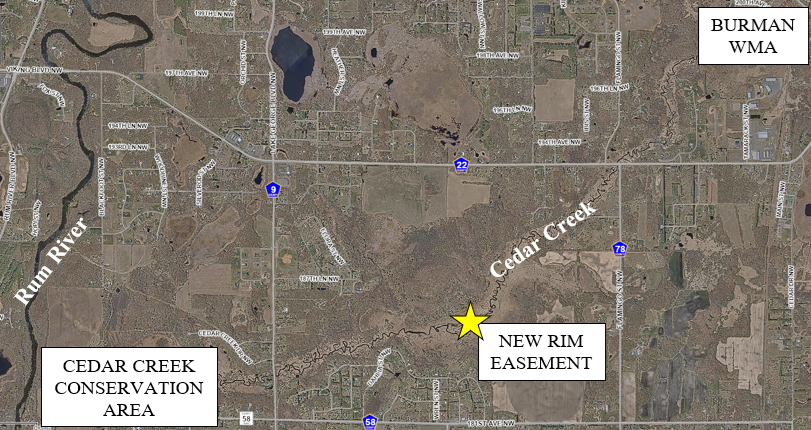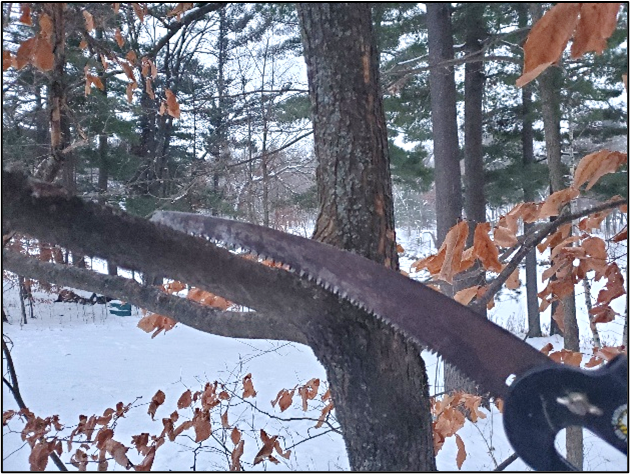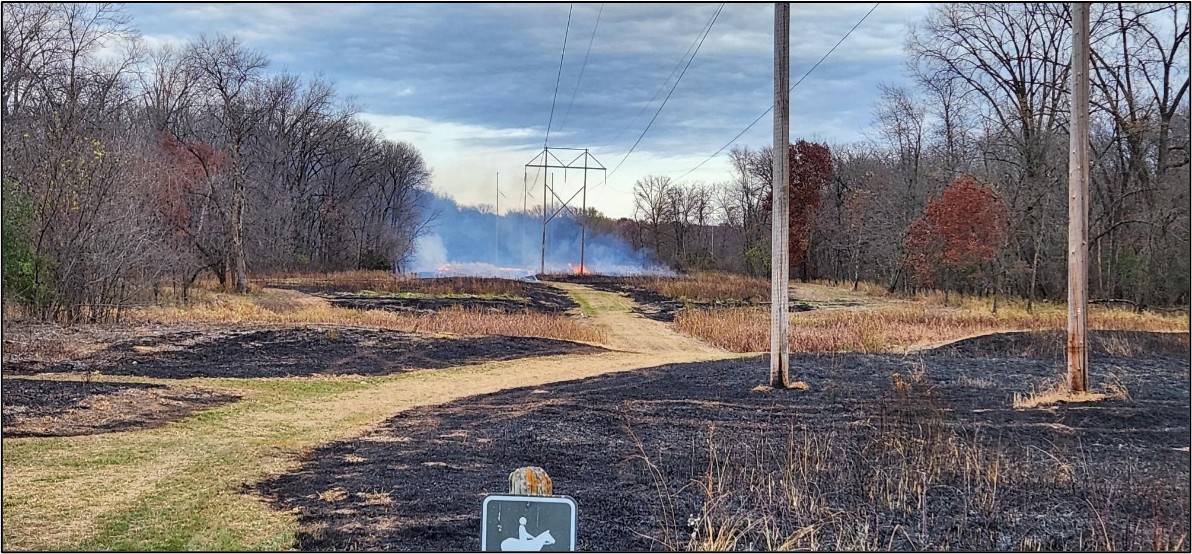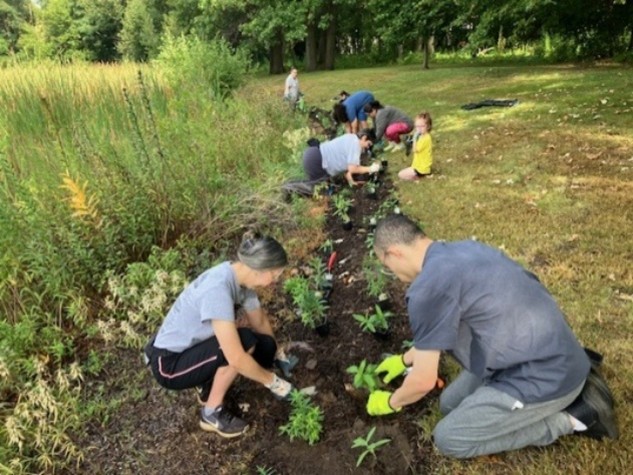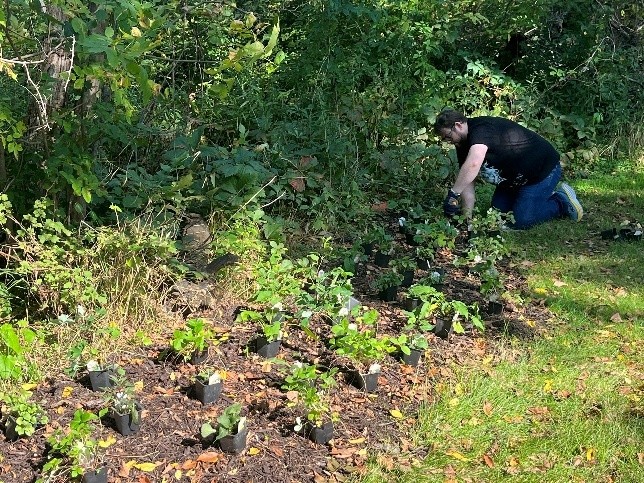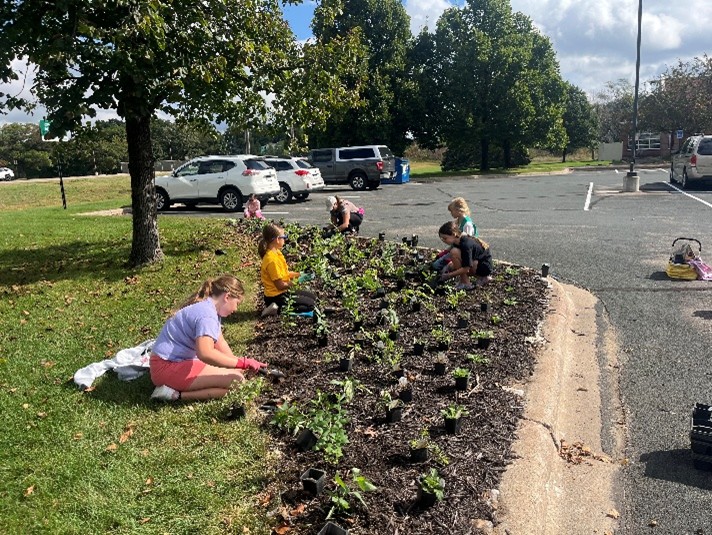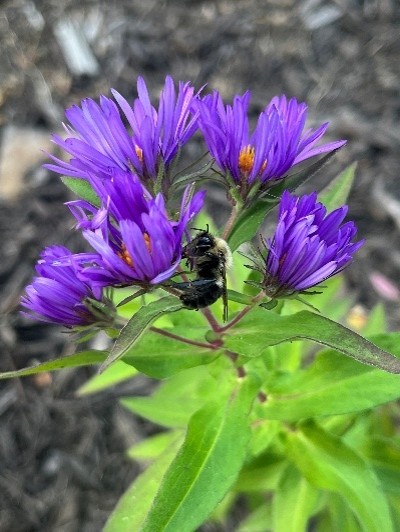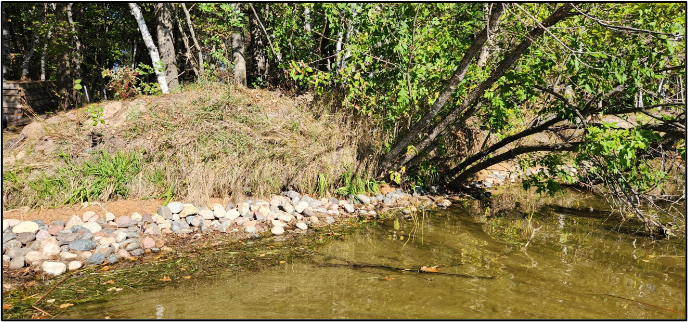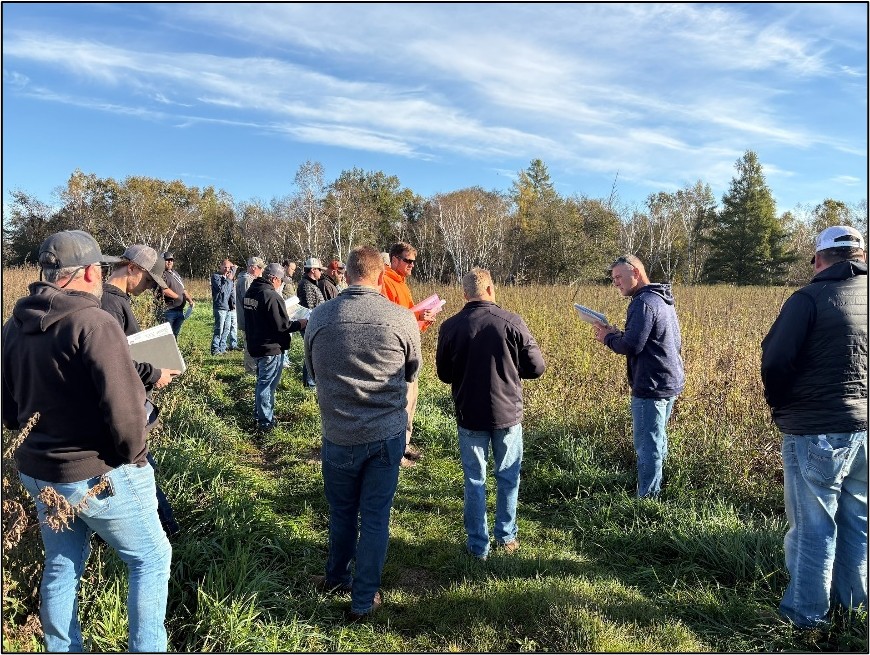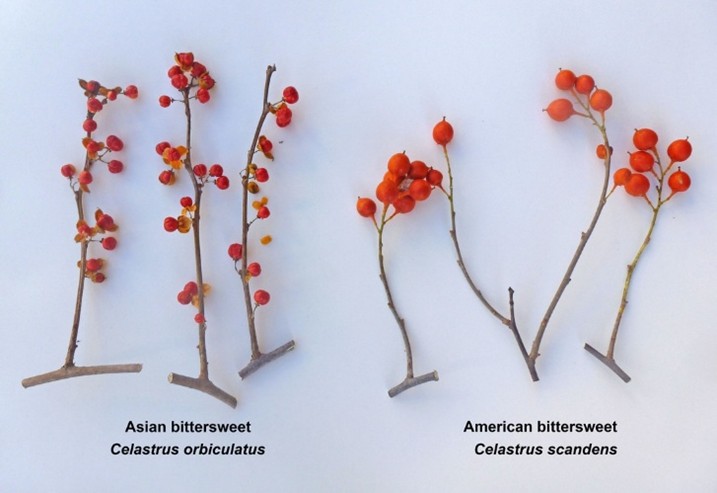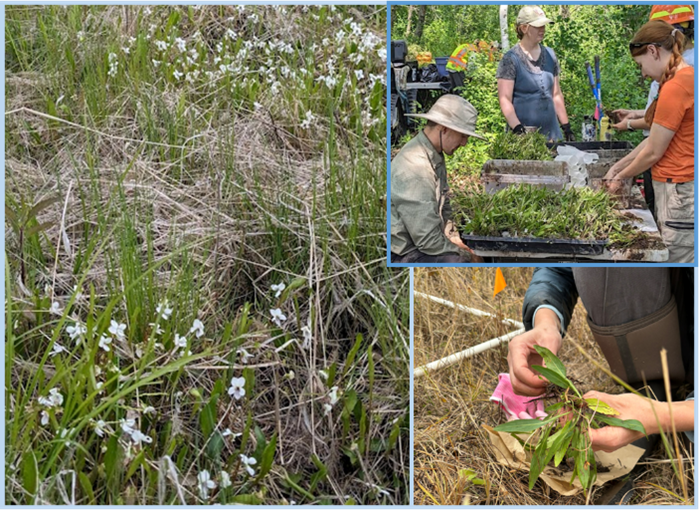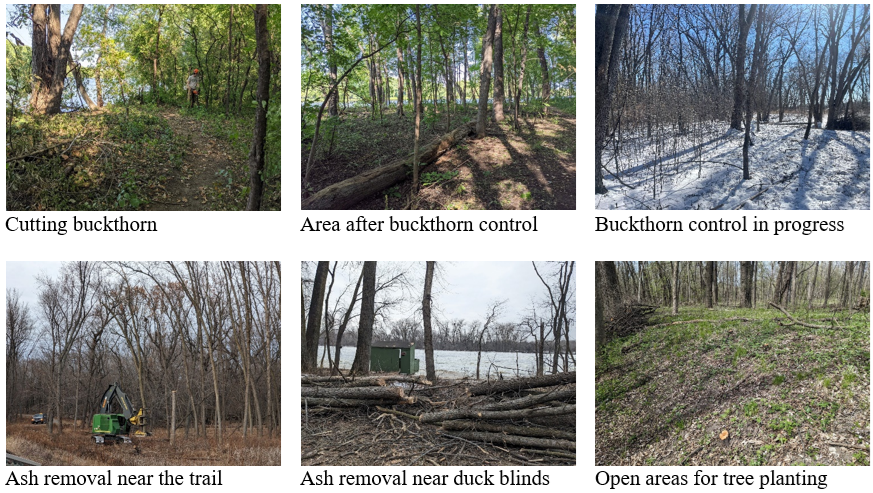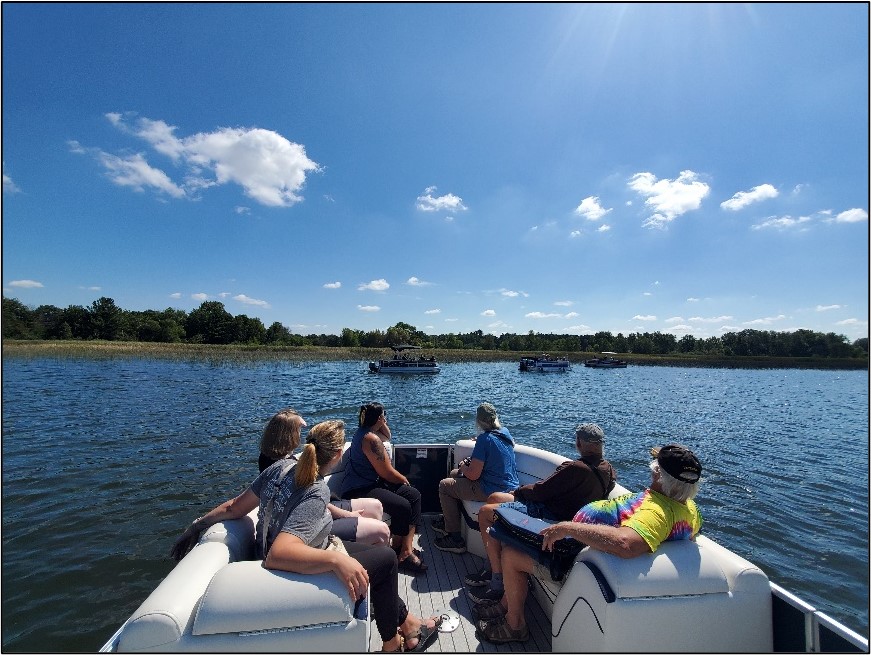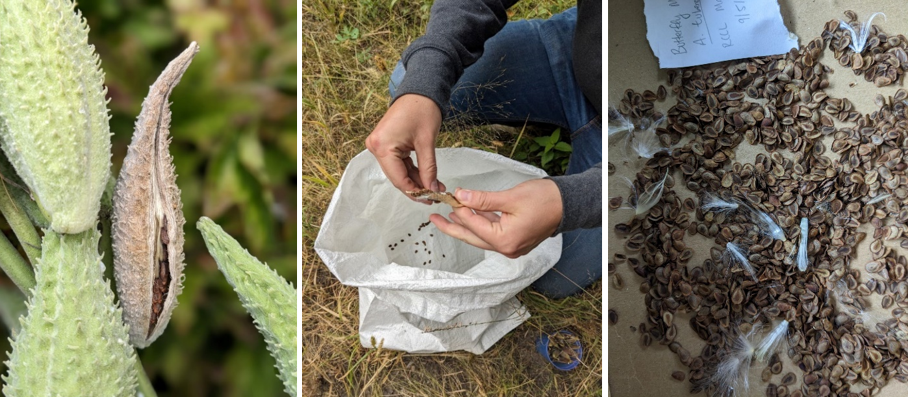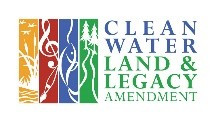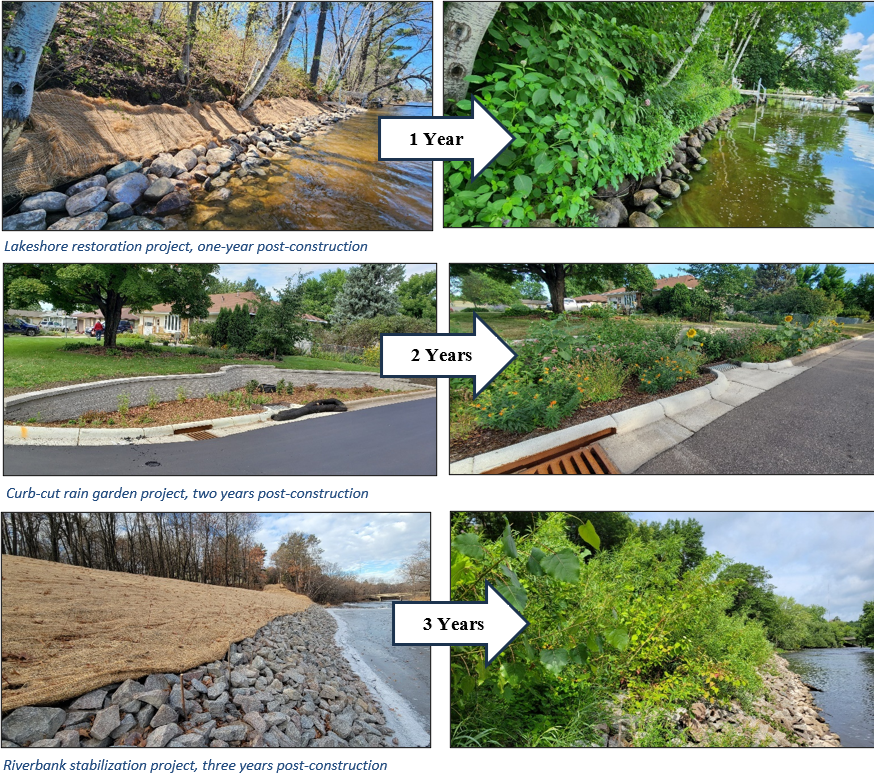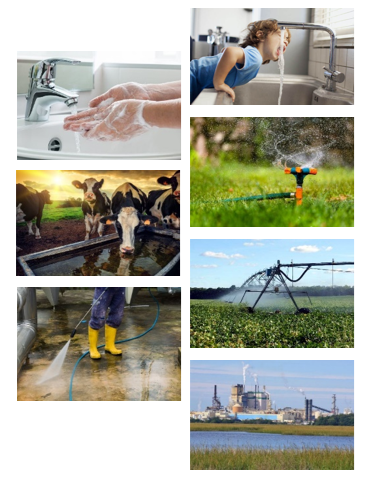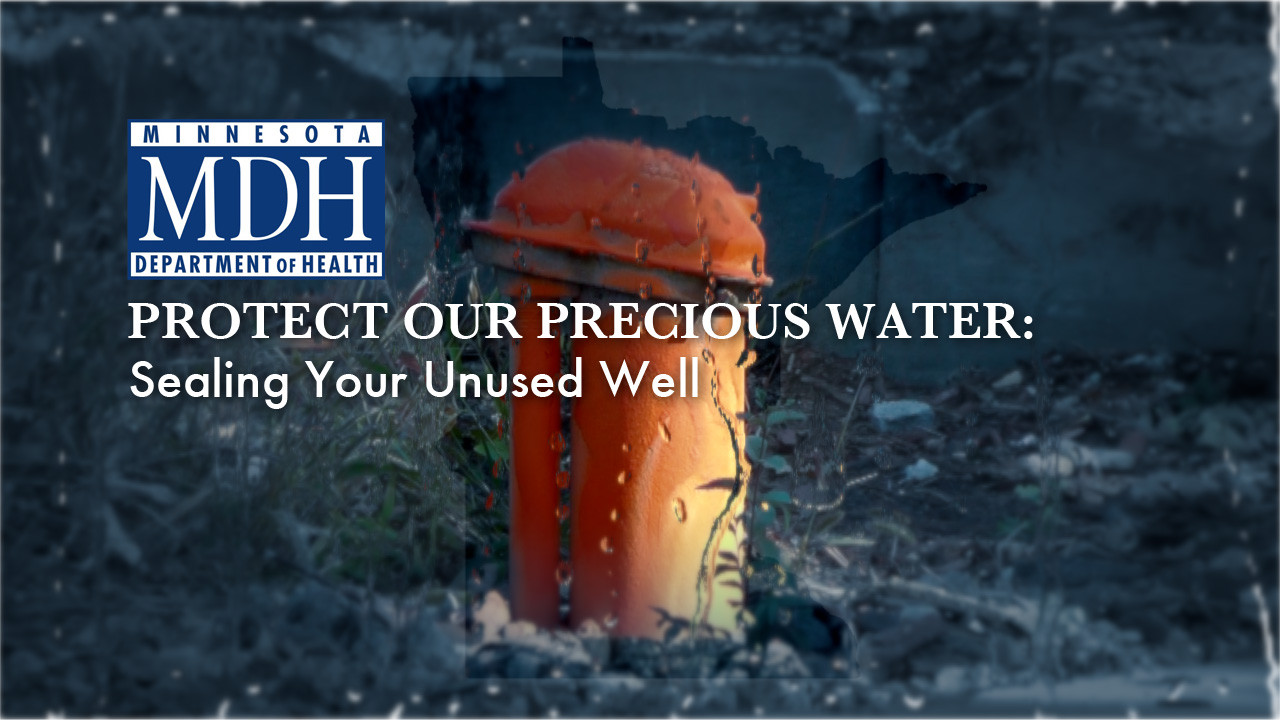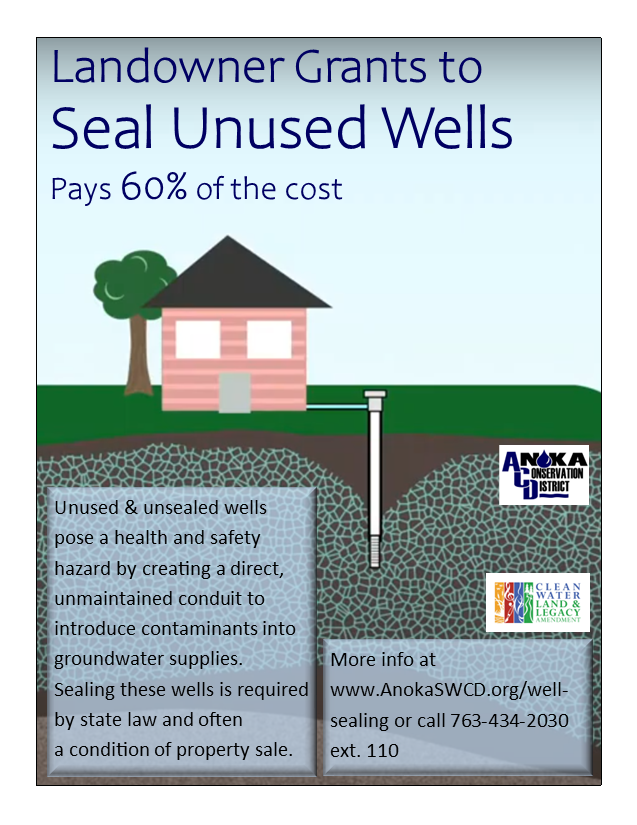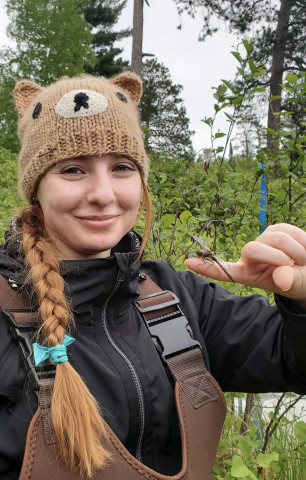The Sloneker family protected 58.5 acres of their land around Cedar Creek through the BWSR's Reinvest in Minnesota (RIM) program. Under the RIM program, the land remains privately owned but is protected by a conservation easement. Land protection along creeks and rivers improves water quality, reduces flood risk, and creates essential wildlife habitat corridors. For more information contact Carrie Taylor, Restoration Ecologist, at
The best time of year to prune most trees in Minnesota is winter. Wounds can heal while pests and diseases are at their winter standstill. It's also a good time to see the tree's form for attractive pruning. If you don't have trees (who couldn't use a few more?), ACD's annual tree sale is open. Trees are now being ordered and will be picked up in the spring. All are seedlings, available in bundles of 10 for $24-30 or bundles of 25 for $46-58. Prairie seed is also available. Please order early for the best selection; we intend to sell out of everything. Order online at www.AnokaSWCD.org. For more information contact Kathy Berkness, Office Administrator, at
Each year, the Anoka County Parks Department uses prescribed burns to manage ~200 acres of prairie and savanna habitats. Fire is a natural part of these ecosystems; it removes accumulated plant material, releases beneficial nutrients, fights the encroachment of woody plants, and helps control invasive species. Through these processes, fire boosts the native plant community and increases diversity. Prescribed burns are often paired with other management techniques such as mowing, applying selective herbicides, and supplemental seeding.
Powerline corridors like this need to remain clear of woody vegetation, providing an opportunity for active prairie management in its place. This restoration also involved treating smooth brome (an aggressive invasive grass) before burning. Visit the U.S. Forest Service webpage to learn more about prescribed burns or contact Carrie Taylor, Restoration Ecologist, at
ACD staff and volunteers planted 120 new trees on Kings Island in Anoka, Minnesota. After more than 420 ash trees were removed due to Emerald Ash Borer infestation, this reforestation effort aims to restore a diverse, resilient forest. Species planted include hackberry, basswood, river birch, tulip poplar, sycamore, northern pecan, and more.
Construction has concluded for nine lakeshore stabilization projects on the Sunrise Chain of Lakes: four on Martin Lake, three on Linwood Lake, and two on Coon Lake. Project locations were selected in 2024 based on the property's need for restoration and the anticipated water-quality benefits the project would deliver. Detailed designs were compiled, and three primary bioengineering approaches were applied.
Funding for these projects was through a Clean Water Fund grant, the Sunrise River Watershed Management Organization, Soil and Water Conservation District (SWCD) Aid, and landowner match. For more information contact Breanna Keith, Water Resource Specialist, at
In 2025, ACD partnered with three Anoka County libraries (Northtown Library, Johnsville Library, and St. Francis Library) to add native pollinator plantings to their properties. These small plantings have converted 650 sq ft of turfgrass into pollinator-supporting habitats and have connected residents to green spaces at their local libraries. We're excited to see these plantings flourish next spring!
This October held the 2025 annual joint meeting of the Lake George Improvement District and Lake George Conservation Club. Members, as well as representatives from ACD, MNDNR, and Lake Restorations Inc., gathered to discuss lake water quality monitoring, aquatic vegetation management efforts, and cost-share opportunities for shoreline enhancement. A couple of highlights from this year include:
- Curly leaf pondweed, a prolific invasive plant, has been almost non-existent in vegetation surveys in recent years. A few plants were found in mid-summer 2025, so management of this plant, along with Eurasian watermilfoil, will continue.
- The native plant community remains robust, with some species of native pondweeds transitioning from non-existent in 2018 to prevalent in 2025, according to the MNDNR vegetation survey data.
- New lakeshore cost-share opportunities will be available next year. Outreach will begin this coming winter or spring. The goal of these projects is to mitigate shoreline erosion using bioengineering practices with rock only as needed.
Several recently installed lakeshore projects feature a new combination of materials to protect from erosion while restoring the native plant community. Our newest approach incorporates the use of rock, coconut fiber coir logs, and a diverse native plant buffer to stabilize shorelines experiencing moderate erosion.
Rock was placed to the elevation at which vegetation struggled to grow and erosion regularly occurred. This elevation is different for each lake and is based on water levels, wind fetch and wave models. The goal was to choose a rock type that would create a more natural look, while still providing protection and function, while preventing undercutting and collapsing of the sandy soils above.
16" coconut fiber coir logs were installed in the zone where water level fluctuations regularly occurred, but vegetation was capable of growing. This log will protect the new plants from wave and ice action while they become established. Eventually, the log will decompose. The coir log was anchored with a new technique using sisal rope and earth anchors for a stronger hold and improved aesthetics.
A buffer of native vegetation was planted behind the coir log. Their deep and interconnected roots will serve as the long-term stability for this shoreline.
This approach also allows for installation with smaller machinery or by hand, facilitating application to shorelines with limited access or a need to work around existing natural shoreline features.
Anyone who has hired a contractor for a project knows you have a lot on the line. You need them to show up, bring the right tools, be knowledgeable, and navigate the inevitable unforeseen consequences. Tackling many construction projects every year, ACD uses a process that complies with the law, seeks out the best prices, and helps us find well-qualified contractors.
ACD often participates in an online competitive bidding process when planning larger construction projects. It's required by law for projects over $175,000. Somewhat recently, competitive bidding meant relying only on newspaper ads and receiving paper bids in sealed envelopes. Today, there are online tools that manage the process. Contractors can automatically receive notifications of nearby projects, download plan sets, and bid online. ACD can communicate with all interested contractors, including answering questions for the whole group. We can ensure everyone has the same information, keeping the playing field fair.
This type of competitive bidding can help bring out the lowest prices for publicly funded projects. On the whole, bids are usually not as close to each other as you'd think. As an example, a recent riverbank stabilization project received 12 bids ranging from $130,393 to $251,021. Government entities are usually directed to select the lowest responsible bidder. ACD takes extra steps to review the qualifications of the low bidder. We may set minimum qualifications and ask contractors to describe their experience, equipment, and expertise. Performance on past projects for ACD and/or its partners is also considered.
Roundleaf bittersweet (Celastrus orbiculatus) is a large woody vine that was introduced in the 1860s. If left unchecked, infestations can overtake and choke out whole forests, with the vines sometimes growing as large as the trees that they grow on!
The best way to tell the difference between the invasive and native American bittersweet is by looking at the fruits (see image above). Additionally, the native bittersweet rarely forms dense thickets like the non native species does. A good way to control large plants of roundleaf bittersweet is to cut the vine near the ground and apply an herbicide solution to the cut stump. Smaller vines can be brush cut or mowed (be sure to collect and dispose of the fruits!) in the winter, and the new leaves can be sprayed with herbicide in the spring.
At the 2025 Columbus Fall Fest, the Sunrise River Watershed Management Organization partnered with the Anoka Conservation District to host a booth packed with conservation resources.
Visitors could learn about:• 🏞️ Lakeshore restoration projects,
• 🐝 Backyard habitat & pollinator plantings,
• 🏡 Septic system replacement programs, and
• 🌳 Our annual tree sale sign-up!
We also had live frogs on display! 🐸
Other conservation partners at the Columbus Fall Fest include the Rice Creek Watershed District, University of Minnesota Extension, and Anoka County Master Gardeners. Together, these organizations highlighted the ways our community is working to protect water quality, restore habitats, and promote sustainable land practices. It was a fun-filled day celebrating both our community and the environment!
For more information, contact Brian Clark, Water Resource Specialist, at
Rare Plant Rescue Planting: Help plant rare lance-leaved violets that were rescued from a development in Anoka County. Please RSVP to plant rescued trees at the Beach Conservation District on Wednesday, October 22nd, at 10 am.
If you have questions, contact Carrie Taylor, Restoration Ecologist, at
Kings Island, in the city of Anoka, has a floodplain forest with a canopy mix of silver maple, ash, and elm. Unfortunately, signs of Emerald Ash Borer (EAB) were discovered in 2021, and some trees started falling on the trail along the Mississippi River. ACD received funding from the Outdoor Heritage Fund in 2023 to conduct ecological management at Kings Island. A total of 426 Ash trees were removed in January 2024.
Ash trees infected by EAB will continue to die off, opening up the forest canopy throughout the island. Tree planting is planned for the fall of 2025 to promote diversity and forest habitat regeneration. Climate-resilient and transition tree species will be planted to enhance the ecosystem in Kings Island. Some of these tree species already exist and some were chosen because they are growing well at the Adaptive Silviculture for Climate Change study at Crosby Farm along the Mississippi River.
Join ACD's efforts to diversify and steward King's Island floodplain forest. Sign up to plant trees at Kings Island on Saturday, October 25th, from 10 am to 12 pm.
Coon Lake, Anoka County's largest lake, was chosen as a research site for invasive cattails by the Minnesota Aquatic Invasive Species Research Center (MAISRC), associated with the University of Minnesota. Residents and natural resource professionals (including ACD staff) were among the ~50 people in attendance in August when their research was shared. MAISRC wants to know whether small-scale mechanical cattail removal can enhance fish habitat, the overall impacts that invasive cattails have on the environment, and the potential benefits of specific management approaches. They have research sites at nine lakes across the state, where they are comparing areas with invasive cattails present to those with cattails removed. Generally, they've found that native, aquatic vegetation becomes established quickly where cattails are removed. They also found healthy responses from fish and improved dissolved oxygen concentrations.
Minnesota is home to both native and non-native cattails, with the latter arriving in the 1940s, if not earlier. However, a hybrid species of the two types of cattails has become the most common and is the most aggressive. The hybrid species creates dense stands, consuming large areas of lake and wetland edges. Eradication is not a possibility and is why management approaches are being researched. Dr. Amy Schrank and her colleagues showed their cattail clearing methods and fish sampling equipment. The cattail removal areas are ~15-foot wide strips. Dr. Schrank emphasized that cattail removal is not being explored just because they can be a nuisance to landowners, but as part of management to improve the health of the fishery and the overall health of the lake.
More information about the research is at www.maisrc.umn.edu/cattails. In Minnesota, a DNR permit is required to destroy or control emergent vegetation, like cattails, in public waters. For more information, see the MNDNR webpage or contact Jamie Shurbon, Watershed Projects Manager, at
ACD was contracted by the Isanti Soil and Water Conservation District (SWCD) to monitor water quality in 7 Lakes, located in the Oxford Township of Isanti County. These lakes are within the Lower St. Croix watershed and have been monitored by the Isanti SWCD since 2017. These lakes have diverse aquatic plant communities, and several rare plant and/or species of special concern have been identified. These natural environment lakes are located in areas of Isanti County that are poised for development in the coming years, making it a crucial time for outreach and education. Conservation agencies such as the Isanti SWCD and the Lower St. Croix Watershed Partnership recognize the importance of using policy and education to help preserve and protect the environment.
Check out this short video on protecting lakes in Oxford Township. The Isanti SWCD is one of the 16 partners of the Lower St. Croix Watershed Partnership, an initiative that looks to protect and restore our water resources for the next ten years. You can learn more about the Isanti SWCD and the LSC Watershed Partnership. For more information contact Kris Larson, Water Resource Specialist, at
Do you have native milkweed plants on your property? If so, early fall is a perfect time to collect seeds. Seeds are mature and ready for collection once they have turned a darker brown. Milkweed pods will turn from green to brown, start to open up and reveal the brown seeds inside. Pods will continue to open and the seed will fly out and disperse. However, it's ideal to collect seeds before the pods fully open and the seed fluff/silk has developed. It is best to remove the fluff from the seed for storage. To separate the seed from the fluff, remove the entire stalk of seeds and fluff/silk from the seed pod, hold the end of the fluff/silk and gently push and pull the seeds off the fluff/silk. Watch this short video to see butterfly milkweed seed cleaning. Once the seed is "cleaned" (the fluff is removed), lay it out to dry completely, label the seed with the plant species name (common or butterfly milkweed), and write the date and location the seed was collected. Store dry seed in paper or mesh plastic bags.
ACD collaborates with Anoka County Parks and cities within Anoka County to enhance local native habitats. If you have native milkweed seed you would like to donate, ACD staff will be happy to take it and spread the seed at appropriate locations.
Contact Carrie Taylor, Restoration Ecologist, at
ACD and the Martin Lakers Association are working together this summer to reduce invasive carp populations in Martin Lake through targeted carp harvests. Our first successful harvest of the season took place in late July, with 58 carp removed. Box nets, designed and installed by Carp Solutions, were deployed at two strategic locations on the lake. The carp are gradually conditioned to feed at these box nets using cracked corn as bait.
After a few weeks of developing a feeding routine, the nets were sprung just before a strong storm rolled in. While the ideal time to spring the nets varies depending on when the carp are feeding the most, weather conditions made this earlier timing necessary. The next morning, the carp were herded to one end of the net, manually lifted into a boat, and euthanized using clove oil before being transported to a composting facility. These efforts are part of a larger project aimed at restoring water quality and aquatic health in Martin Lake. For more information contact Brian Clark, Natural Resource Specialist, at
Each year, ACD staff revisit a variety of previously installed projects to ensure that they are holding up throughout their expected lifespan. For the project owners, this is an opportunity to reconnect with technical experts and ask questions. For project managers, this improves our understanding of which materials and approaches result in the greatest success over time. For the projects themselves, this helps address issues before they become unmanageable, ensuring the natural resource benefits provided continue for years to come.
This year's project visits include streambank and lakeshore stabilizations, rain gardens, pollinator plantings, and habitat restoration projects. For each, a checklist of items is assessed and new photos are collected. In addition to closely inspecting structural elements, we're also analyzing vegetation establishment. Native vegetation plays a role in nearly all projects. Active management – especially during the first few years after seeding or planting – is typically needed to support robust native plant growth and control invasive and weedy species. Our findings from these inspections will allow us to improve our maintenance guides for landowners installing conservation projects. For more information contact Breanna Keith, Water Resource Specialist, at
A fundamental aspect of managing any pest is correctly identifying it. Historically, identifying weeds has involved using some form of a taxonomic tool. Fortunately, technology has advanced significantly in assisting with plant identification; several free and paid mobile applications are now available to the public. PictureThis and iNaturalist apps both have free versions that rely on some form of community-supported identification. Major phone manufacturers are also increasing photo recognition abilities in their camera apps. Android uses Google Lens to search the internet for similar-appearing photos to help identify a plant or other object. Apple's IOS uses Visual Look Up to perform a function similar to Google's.
Each of these platforms has its advantages and disadvantages, and each should be used with a healthy dose of skepticism. Unfortunately, these apps are not very reliable at correctly identifying grasses, so they are somewhat limited to broadleaf plants. Remember that these apps are simply a tool to help you correctly identify a plant. They will likely improve in accuracy as cameras and computer processing improve over time.
Read the full article in the latest edition of the "Home Lawn Care Newsletter" from the University of Minnesota Turgrass Science. Other topics include encouraging better rooting through improved watering practices, utilizing technology to identify weed species reliably, and learning how to manage your lawn for moles, as well as upcoming events. For more information, contact Becky Wozny, Wetland Specialist, at
ACD staff have been working hard this season to remove garlic mustard seed from a woodland restoration site in Coon Rapids Dam Regional Park. By removing these biennial plants in their second year of growth, we aim to drastically reduce the seed source for new garlic mustard plants. With this reduced seed source, we hope to find fewer new garlic mustard plants when we return next spring. For more information, contact Jordi Johnson, Restoration Technician, at
ACD has developed informative videos on a variety of topics, all of which can be accessed on ACD's website and YouTube Channel. The videos cover topics such as signs and causes of erosion, river-friendly lawn care, and various best management practices. The "Our Connection" video series is both informative and easy to follow, and has become a valuable educational tool for teaching students about the environment. For more information contact Kathy Berkness, Office Administrator, at
Mussels, often referred to as clams, can be found in many lakes and rivers in Minnesota. Of the 51 freshwater mussel species that have historically lived in Minnesota, 28 are now gone, endangered, threatened, or of special concern. None of them are legal to catch or relocate. If a rare mussel has been identified in an area of a lake or river where a project is proposed, the permit process grinds to a halt. At the same time, experts with specialized certifications are called in, equipped with scuba gear, to carefully locate and relocate mussels from the construction zone. Few people have the necessary expertise and it can take a long time to get one to a job site. The not-so-rare mussels are left to fend for themselves.
All of this intersects with the Anoka Conservation District's (ACD) services, as we often help property owners on lakes and rivers address excessive erosion. Left unchecked, bank erosion can impair water quality, smother wildlife, and damage property and infrastructure. We've been fortunate to avoid all identified rare mussel populations and the permitting challenges that come with them. We started thinking about what would happen if our luck runs out and asked ourselves, "What if we could come up with a way to safely relocate all mussels from all construction zones without hiring Scuba Steve?" We may have come up with a solution that contractors could implement with readily available equipment at a reasonable cost, but first, there are some things you should know about mussels.
Mussels are interesting creatures. When they're born, they must immediately latch onto the gills of a fish, where they live rent-free until they are large enough to drop off and sink into the sand. Each mussel species can only pair up with a specific fish species. Some mussels live over 100 years and most of that time is spent in the top 4 inches of sand and gravel in lakes and rivers. Most mussels prefer to hide in river or lake bottoms with only their mouths sticking out of the sand. Mussels eat by siphoning water and filter out microscopic organisms and plant material that are floating by. They are like HEPA filters, purifying our water bodies. While mussels can move several feet a day to escape dropping water levels, they often spend their entire lives within an area smaller than a kitchen table. They are fairly helpless, except that some local species have such hard and sharp shells that they earned the name heel-splitter, yikes!
We explored numerous ideas before settling on one that we believe has promise. Those left on the cutting room floor included:
- doing nothing because then all of the mussels would die;
- excavating out the soil in the construction zone because the mussels would likely be crushed and die;
- using a rake or sieve because only large mussels could be extracted and the rest would be left to die; and
- hydro-excavation using an impeller because it's difficult to control and needs an electrical power supply, which near water would set up the operator potentially to die.
All of those options simply involved too much dying. So, we landed on using hydro-excavation, using a high-pressure water pump to blow the top 4" of sand and gravel out into the water and out of the construction zone.
ACD staff couldn't test this theory on actual mussels because it's illegal to handle and relocate live mussels. Therefore, we chose areas without any known mussels and conducted experiments to determine how effectively we could remove the top layer of soil from the construction zone. Logically, if we could successfully relocate the top 4" if soil out of the construction zone, we would also relocate all of the mussels within that soil. The process involved pumps, hoses, rebar, waders, underwater cameras, tablets, measuring instruments, and talented staff. After much well-documented trial and error, we honed in on a process that did the best overall. This can all be found in a recently completed report, "Mussel Mitigation Techniques: Exploring Sediment Relocation Protocols to Reduce Construction Zone Impacts." Soon, this report will be forwarded to DNR staff who specialize in mussel conservation, where we hope the ideas will be explored, refined, and codified into formal recommendations. With a bit of effort and open-mindedness, perhaps we can end the era of letting the 'not-so-rare' mussels fend for themselves.
This analysis was completed in part with funding from the Outdoor Heritage Fund of the Clean Water, Land, and Legacy Amendment.
Are you sick of goose poop covering your lawn? Plant a buffer of native grasses, flowers, and shrubs along your shoreline to keep them out! Geese are drawn to open spaces with short, well-fertilized grass, which provides them with a buffet of their favorite food and a sense of security with the ability to easily spot predators. Add water (your lake) to the mix, and you've created an easily accessible 'goose haven'. Taller, denser vegetation along the water's edge deters geese from accessing your lawn from the lake, encouraging them to move along in search of greener pastures.
The thicker the buffer, the more effective it will be. Not only do buffers discourage nuisance wildlife – they also provide a multitude of other benefits, including protecting your shoreline from erosion, improving water quality, and providing food and habitat for pollinators. You can use this helpful collection of technical resources, produced by the Minnesota DNR, to plan your buffer project. For more information, contact Breanna Keith, Water Resource Specialist, at Breanna.Keith@AnokaSWCD.
Unlike our sanitary sewers, water, trash, and other debris entering storm drains are not routed to a treatment facility; instead, they drain into wetlands, lakes, and rivers. Some stormwater pipes drain directly to these waterbodies, while others may first pass through features like manmade ponds to provide some treatment. In either case, reducing pollution at the source is the most effective way to protect our local waters. To this end, the need to keep trash and debris out of the streets is clear. However, when flushed down the storm drain, even organic plant materials such as grass clippings, leaves, and other yard waste also contribute to harmful nutrient pollution, causing algae blooms, reduced oxygen levels, and other issues in downstream waters.
Keeping excess plant material out of the street isn't just beneficial for water quality; it also prevents flooding, reduces the cost of storm sewer maintenance and repair, and improves travel safety. It's for these reasons that intentionally blowing leaves, grass clippings, or other materials into the street is illegal in most Minnesota cities. Instead, dispose of them at your local compost facility or through a curbside yard waste provider. If you'd like to play a more active role in improving stormwater quality, consider becoming involved in the Adopt-a-Drain program. For more information contact Breanna Keith, Water Resource Specialist, at
As summer warms up, the likelihood of harmful algae blooms increases. Cyanobacteria, also known as blue-green algae, are a type of photosynthetic bacteria. Cyanobacteria are naturally found in all lakes, rivers, and ponds, and, like plants and algae, they perform photosynthesis, obtaining their energy from the sun. Unlike true algae, cyanobacteria aren't a key part of the food chain, and most organisms choose not to eat them. Under the right circumstances, cyanobacteria can multiply to form a bloom. A bloom is a sudden increase in cyanobacterial cells in a specific area of water. Some species of cyanobacteria can create toxins that are harmful to human and animal health, known as cyanobacterial harmful algal blooms (cyanoHABs).
CyanoHABs can make people and animals sick if they breathe in, swallow, or come into contact with water or scum that contains toxins. Sunlight, high temperatures, and abundant nutrients, such as phosphorus and nitrogen, can increase the likelihood of a bloom occurring. Warm weather patterns and significant rain events that result in more stormwater runoff entering the water can also jump-start a bloom. Blooms typically occur during the warmer months, between mid-June and mid-September. As Minnesota's climate changes, it's fueling more frequent and intense rain events, floods, and warmer weather, contributing to more harmful algal blooms. For more information, check out the Minnesota Pollution Control Agency webpage or contact Kris Larson, Water Resource Specialist, at
ACD has been out in the field, monitoring the water quality and water quantity of Anoka County's streams and rivers. Stream water quality monitoring is conducted to detect and diagnose water quality problems that impact the ecological integrity of waterways, recreation, and human health. Since many streams systems are connected to lakes, water quality in streams is often studied as part of lake management. Hydrology is the study of water quantity and movement. Knowledge regarding the amount of water flowing in a stream helps engineers and natural resource professionals understand the effects of rain events, land development, and stormwater management. This information is often paired with water quality monitoring and used to calculate pollutant loadings, which are used in computer models and water pollution regulatory determinations.
Flowing water eats away at the soil on the lower bank along the outside curves of rivers. The water is piled against the outside of the curve as the river bends, similar to the sensation of being pushed to the outside of a fast-turning car. This flowing water scours material away, causing the bank to collapse. A common and effective method of preventing erosion is to armor the bank with a robust layer of material that cannot easily be moved or washed away by the current, such as rock. This results in a bank armored against erosion, but it does not allow vegetation to flourish on the part of the bank covered in rock. It also doesn't help dissipate the energy of that flowing water, which can then be exacerbated downstream. It often requires the entire armored length to be clear-cut and graded.
An alternative to armoring is to redirect the river's flow from the outer bank, thereby preventing scour through deflection. An effective way to do this is to angle rock barbs or weirs upstream into the channel. This forces the water to flow around and over at a perpendicular angle. This pushes the main flow back towards the center of the stream rather than along the outer bank. Often, a deep pool is made just off the end of the weir towards the center of the channel. This causes variable flows and depths within the channel that fish and other organisms like. ACD has recently implemented bendway weirs and plans to install more in the near future. For more information contact Jared Wagner, Water Resource Specialist, at
A rain garden was recently completed to benefit water quality in Coon Lake. This is the third rain garden in that neighborhood, each treating stormwater from a different section of the street. Previously, all curbside runoff was piped to the lake. This project was a collaboration between the Sunrise River Watershed Management Organization, ACD, and the landowner. Funding was from a grant from the Clean Water, Land, and Legacy Amendment.
Thanks to the Volunteers, Conservation Corps, and Three Rivers Park District staff for joining the ASP Rare Plant Rescue team to rescue state threatened Viola lanceolata, state Endangered Carex pallascens, and state Threatened Trichophorum clintonii from an area that will be dug up and developed soon. Those plants will temporarily grow at the MN Landscape Arboretum during the hot summer. In the fall, we will plant them into ecologically appropriate habitats on protected lands where they will be monitored.
Stay tuned for a volunteer planting event in the fall. Sign up to be added to the Volunteer List. Learn more about the ASP Rare Plant Rescue. For more information, contact Carrie Taylor, Restoration Ecologist, at
Vernal pools are shallow wetlands that fill with water in the spring and fall, then often dry out in the summer. They may appear like large puddles, but these depressions are brimming with life and help improve water quality. By capturing water from snowmelt and heavy rainfall, vernal pools reduce the amount of runoff (and therefore the contaminants it carries) reaching nearby surface waters and developed lands. This lowers flooding risks, improves water quality, and contributes to groundwater recharge as the trapped water slowly infiltrates through the soil.
Vernal pools rarely contain fish because their water levels fluctuate dramatically. This creates a safe haven for many amphibians and aquatic invertebrates that would otherwise be heavily preyed upon. While some depend on vernal pools during only their vulnerable egg and larval stages, others spend their entire life within or near them. These small wetlands also provide food, water, and refuge for many other wildlife species such as ducks, turtles, and snakes. Benefits stem beyond the pool itself as several aquatic insect larvae transform to flying adults, serving as forage for insectivores like songbirds and bats.
Vernal pools are highly sensitive to environmental changes. Because they are nearly invisible for much of the summer, they can be easily missed and destroyed if the land is modified. You can help protect vernal pools on your property by noting their boundaries when visible in the spring and avoiding disturbance throughout the year. This is also a great time to explore the abundance of wildlife in and around these wetlands! For more information contact Breanna Keith, Water Resource Specialist, at
Additional Resources
"Spring-to-Life Ponds": an Illustrated Learning Guide, produced by the MNDNR
MN Frog ID and Calls and Common Vernal Pool Invertebrates, produced by the MPCA and the University of Wisconsin
Locating and Protecting Vernal Pools, produced by the MN Land Trust
ACD has secured over $78,000 - including $71,000 in state Watershed-Based Implementation Funds and $7,100 in local matching funds from the City of Fridley - to revitalize aging rain gardens in the Coon Creek Watershed.
Many rain gardens are now beyond their original 10-year lifespan, yet still hold potential for managing urban stormwater runoff. This project will remove accumulated sediment, repair infrastructure, and improve plantings within up to 10 rain gardens. The work will increase the rain gardens' ability to capture and filter pollutants from stormwater runoff, thereby reducing phosphorus by an estimated 5.2 pounds annually for the next decade.
These efforts represent targeted investments in existing infrastructure to provide cost-effective water quality benefits. Existing rain gardens in the Coon Creek Watershed that are 10+ years old will be analyzed, and those with the most benefit potential will be revitalized. Maintenance agreements will help ensure long-term success.
Work will begin in 2025 with site analysis, potential benefit estimates, ranking, and site selection. Designs, bidding, and rain garden revitalizations will follow. For more information, contact Mitch Haustein, Stormwater & Shoreland Specialist, at
Designs have been completed and construction planning is underway for nine shoreline restorations on Martin, Coon, and Linwood lakes in Anoka County. Sites were selected based on the severity of erosion, and therefore the amount of nutrients and sediment they're contributing to the lake. A variety of 'bioengineering' approaches will be applied, utilizing natural materials such as vegetation, wood, coir logs, and rock to stabilize the shoreline while enhancing habitat for fish and wildlife. Funding is provided by a Clean Water Fund grant, the Sunrise River Watershed Management Organization, and landowner match. Stay tuned for more updates! For more information contact Breanna Keith, Water Resource Specialist, at
The 2026 budget request to Anoka County includes adding a Groundwater Specialist to ACD's staff. This is the third consecutive year that this need has emerged as a top priority. Anoka County has never had a professional dedicated solely to managing our groundwater. Given our situation, it's time to shift our priorities. What situation?
- 94% of us in Anoka County rely on groundwater for drinking and other needs
- We have more private wells than any other county in MN (53,000)
- We have more Superfunds sites than any other county in MN (9)
- We sit on the Anoka Sandplain, making our drinking water highly vulnerable to contamination
- Our shallow groundwater recharges aquifers relied on throughout the Metro Area.
This combination of factors can come together in troubling ways.
- Drinking water contamination in Andover neighborhoods near closed landfills.
- 47 private wells in Blaine and Ham Lake went dry due to interference from municipal well pumping in the City of Blaine. Three Blaine wells had to be shut down.
- "Forever chemicals" (PFAs) are showing up in groundwater across Minnesota, especially in Anoka County. Potential health ramifications are unknown.
- Drought diminished shallow groundwater, resulting in record-low lake and river levels.
- Multiple train derailments across the country exposed the vulnerability of drinking water to contamination by spills. Anoka County must be prepared to respond quickly to spills.
If only we had a Groundwater Specialist at ACD, we could:
- Develop a groundwater management plan and secure state approval,
- Secure $150K-$350K/year in state funds available to those with approved groundwater plans,
- Use advanced technology for high-resolution groundwater modeling,
- Analyze neglected datasets for hotspots and trends in groundwater degradation,
- Engage MPCA, MNDNR, and MDH to enhance the service Anoka County constituents receive,
- Coordinate regional planning, wellhead protection, and contamination response,
- Implement sentinel well monitoring,
- Manage cost-share programs for projects like septic upgrades, well sealing, and agricultural irrigation technology upgrades,
- Inform civic leaders, public employees and the public at large on groundwater, and
- Serve as the trusted expert on groundwater issues.
If groundwater is a mystery to you, please watch the short videos linked below, which were made locally and are often referenced nationally.
Groundwater - https://www.youtube.com/watch?v=gxENTkMmyEE
Groundwater Contamination - https://www.youtube.com/watch?v=gRSHJpe8pq8&t=12s
When confronted with something eating your prized tomato plant, sometimes our first instinct is to pick up the bottle of pest spray. Oftentimes, we don't even realize that the plants we've purchased contain neonicotinoids, which are systemic (within) the plants' leaves, stems, flowers, nectar, and fruit. These 'neonics' are highly effective in killing pests, but they lack discrimination, and mounting evidence suggests they are contributing to the decline in pollinator numbers. An alternative is called IPM or Integrated Pest Management. The concept is to address pest infestations as they occur and manage pest damage on an as-needed basis, rather than chemically on a predetermined schedule.
Cultural practices may include:
- Is it a pest? Many of our most beautiful butterflies will use our garden or yard as a source of food, as well as caterpillars! If you can't identify the insect snacking on your plant, try contacting the Anoka County Extension Service for help with identification or go online. There are free apps that can help identify many insects, including iNaturalist, which can also help identify plants
- Regular compost additions to maintain a healthy population of soil organisms
- Crop rotation to avoid inadvertently helping pests thrive via monoculture
- Companion planting to attract beneficial insects while reducing the attraction of pests
- Using physical barriers like fine mesh netting and row covers to prevent pests from reaching crops
- Hand removing larger pests from plants when practical, Japanese beetles are a good example. Late afternoon is a good time to find these bugs and dispose of them in soapy water.
- Maintaining garden hygiene by removing diseased and end-of-season vegetation from the garden and disposing of it properly.
Biological and habitat controls include:
- Importing predators and parasitoids that prey on the pests of concern. Note that specific pests demand specific predators and predators need a food source to stay in the garden area. Generally, if you have managed your garden then the 'good' insects will naturally find their way to your garden and assist with pest control.
- Maintaining a chemical-free habitat that is welcoming to beneficials and pollinators
- Using resistant plant varieties means researching and selecting the best available hybrids that are resistant to likely pest challenges.
When nothing else works and damage levels warrant continued action, research the organic and manufactured chemical options for the specific pest in question. Insecticidal soaps are a good option for many sucking and chewing pests. Neem oil is similarly safe on food with no dangerous residues while killing or reducing pests, powdery mildew, and other fungal infestations. If all else fails and traditional pesticides are used, follow label directions carefully, use them minimally, and avoid spraying open flowers and applying them during the day when pollinator activity is highest.
The Harder Path is the Right Path
As is often the case, the more convenient approach — using neonicotinoids and other chemicals on a widespread basis in anticipation of pest problems — is seductive but ultimately harmful in the long term. Damage to pollinators, faster evolution of resistant pests and replacement of natural processes with chemicals are all costs that eventually have to be faced. The IPM approach requires more work and acceptance of a certain amount of pest damage. We must reduce and manage the use of neonicotinoids and other agricultural chemicals, as their long-term impact will be far more harmful than beneficial. Do it for the bees. Do it for the butterflies. Do it for the birds. Do it for you.
An excellent resource for more information is the University of Michigan's website: https://ncipmhort.cfans.umn.edu/ipm-bmp-cultural-control/vegetable-garden-best-management-practices-pollinators.
Spring is the perfect time to upgrade your lawn irrigation system. Smart irrigation tools—such as Wi-Fi-enabled controllers, soil moisture sensors, and rain sensors—help your system adjust automatically based on weather and soil conditions. These upgrades take the guesswork out of watering and prevent overwatering.
Thanks to the Metropolitan Council's Water Efficiency Grant Program, funded by the Clean Water, Land, and Legacy Amendment, several Anoka County cities are offering rebates for smart irrigation controllers that reduce water waste and lower your water bill. Click the links below or check with your city to learn more about eligibility and how to apply.
- Smart irrigation controller rebates: Centerville, Coon Rapids, Fridley, Lino Lakes, Ramsey
- Irrigation audits to assess water efficiency: Fridley
Smart irrigation is a simple, effective step toward more resilient water resources—right here in Anoka County. Visit the University of Minnesota Extension's Lawn Care website for additional lawn management resources. For more information contact Mitch Haustein, Stormwater and Shoreland Specialist, at
ACD is seeking a group, company, or individual to provide $1,000 per year in support for the St. Francis High School biomonitoring program. Our past sponsor has had to withdraw due to financial constraints. Each year, we take high school biology classes to the Rum River to catch and count macroinvertebrates (bugs, crustaceans, etc.) that live there. Because some of these critters require high-quality conditions, we can use them to calculate metrics of river health. It's hands-on education led by professionals, with implications beyond the classroom. This program has been going since 2001. 1,950 students (average 81/yr) have donned waders, grabbed a net, and learned about the Rum River.
Financial assistance is used to help cover the costs of waders, nets, and other necessary equipment. It also ensures that our natural resource professionals can provide instruction and help students discover what their data means. Any group willing to provide financial assistance can please contact
An early thaw and record-breaking warmth have turned the typical spring emergence of ticks into an explosion of them. Anoka County is a high-risk area for tick born disease according to the MN Dept. of Health. The two primary types of ticks Minnesotans are likely to pick up afield are American dog (wood) ticks and Blacklegged (deer) ticks. While wood ticks can transmit disease to humans, it is rare. Blacklegged ticks (or deer ticks) however, carry a bevy of diseases transmittable to humans. Some of these diseases can cause lifelong illness and suffering. Luckily, there are some easy strategies to implement while outdoors to reduce your chances of being bitten and infected:
1. Treat clothing with Permethrin. Unlike typical "bug spray", permethrin is used to treat clothing before going outdoors. It should not be applied to the skin. Permethrin is the most effective deterrent against ticks, and it also keeps mosquitoes and flies away.
2. Wear long pants, sleeves, and boots. Tuck your pants into your socks and shirts into your pants to reduce openings to your skin. Light colored clothing makes ticks easier to see.
3. Try to stick to mowed areas or trails if possible.4. After being in the field, immediately check all clothing and skin. Learn about tick life cycles and study photos of them to be well-prepared for identification. The MN Dept. of Health has a practical tick guide: https://www.health.state.mn.us/diseases/tickborne/ticks.html
ACD wraps up another successful annual tree sale! Over 26,000 trees were purchased as bare-root seedlings in bundles of ten or twenty-five. We offered a variety of species including black cherry, mixed oak, maple, lilac, pine trees, and a variety of native prairie seed mixes. We had perfect weather on pick-up day and our staff enjoyed getting the chance to meet and engage with the 466 tree sale customers. Thank you to everyone who purchased trees and helped support local conservation efforts! Check out a recap of our 2025 Tree Sale below!
Our Watershed and Stormwater Connection
This video explains complex concepts about watersheds and stormwater in simple terms using engaging animation. It benefits all ages, from an elementary classroom to a city council chamber. Learn what watersheds are, why they are important, and some challenges watershed managers face. This ties into stormwater management and what public officials are doing to prevent flooding and improve water quality, as well as what we all can do to become part of the solution. https://youtu.be/pqdPe3Lvuao
Our Stormwater Pond Connection
Stormwater ponds are a common feature in many neighborhoods, and for many landowners, they are part of their backyard. This video uses simple terms and engaging animation to explain how stormwater ponds help keep our lakes and rivers clean. It also sets expectations for what is normal for your neighborhood stormwater pond, and perhaps more importantly, what not to expect. The video closes with practical advice on what to do to enhance stormwater ponds. https://youtu.be/R80kXDOmyq0
Emergent aquatic plants such as cattails, bulrushes, and sedges grow within the shallow margins, or "littoral zone", of most lakes in Minnesota. They improve water clarity as their roots stabilize the lakebed sediments and take in nutrients. Their stems and leaves provide habitat for fish, invertebrates, and amphibians below the water, refuge for waterfowl and other wildlife above the water, and protection for shorelines against the force of wave action. Emergent plants often grow alongside other aquatic vegetation, such as floating-leaf and submerged plants, creating a diverse habitat essential to lake health.
Any Destruction of Emergent Vegetation Requires a Permit in Minnesota
Lakeshore owners often wish to remove emergent vegetation to improve their access to open water and/or increase usable recreational space. Given its importance in improving water quality, providing habitat, and protecting shorelines from erosion, any removal of aquatic emergent vegetation requires a permit from the Department of Natural Resources. This process connects landowners with professionals to ensure that the extent of vegetation removal (and methods used to achieve it) minimizes impacts to the lake and all who use it. Learn more about aquatic plant regulations HERE.
Non-native emergent species such as narrow-leaf and hybrid cattails often grow in dense monocultures capable of outcompeting native species. Habitat quality and recreational usability are reduced as these invasions spread across large expanses of shallow water, but management efforts to remove them are often challenging and costly. When occurring in small clusters, these plants can still provide water quality benefits along disturbed shorelines where native emergent plants are absent. In either circumstance, removing a non-native or invasive emergent species requires a permit.
Aquatic vegetation is a natural and essential part of lake and wetland environments. The abundance and types of plants present are primarily driven by water depth and clarity. Many lakes in the north metropolitan area are shallow (less than 15 ft. deep) or are more functionally open-water wetlands. These lakes usually contain abundant vegetation throughout when paired with good water quality, allowing sunlight to reach the bottom. The alternative is poor water quality from disturbances such as excessive nutrient inputs, reducing aquatic vegetation and the fish and wildlife that depend on it. Learn more about shallow lake vegetation from this StoryMap produced by the Rice Creek Watershed District: Aquatic Plants: Guardians of our Shallow Lakes.
For more information contact Breanna Keith, Water Resource Specialist, at
ACD makes it easy to spread the word about conservation by developing a series of "Conservation Starts at Home" tabletop displays and brochures. Whether you're hosting a table at an event or distributing information in another way, like at a public library, church, or school, ACD's educational materials make it easy for community members to have an impact. These resources are available to the public free of charge.
Each year community members and agency partners use these materials at local events and distribute hundreds of brochures to the public across a wide variety of topics including :
• Backyard Habitat* - Attracting Wildlife to Your Property
• Ecosystem Health - Improving Landscapes by Increasing Diversity
• Groundwater* - Protecting Drinking Water for Generations to Come
• Invasive Species - Combating a Threat to Native Ecosystems
• Lakeshore Restorations* - Bringing Water Quality & Wildlife to Your Shore
• Native Plants* - Restoring Habitat in Anoka County
• Natural Resource Threats - Threats to Our Natural Resources
• Open Space Protection - Establishing an Enduring Legacy
• Pollinators* - Enabling Our Farms, Gardens and Natural Spaces to Thrive.
• Rain Gardens* - Treating Runoff at the Source
• Riverbank Stabilization* - Understanding Flow & Managing Erosion
• Soil Health - Unlock the Secrets in the Soil
• Stormwater Management* - Improving Water Quality and Reducing Runoff
• Water-smart* - Conserving Water at Home
• Wetlands* - Benefiting Wildlife and People
(*Display has companion brochure)
Up to three displays typically fit nicely on a table. Many of the displays have companion brochures. We are happy to provide up to twenty brochures for each topic free of charge, if you'd like. For more information contact Kathy Berkness, Office Administrator, at Kathy.Berkness@AnokaSWCD or 763-434-2030x100.
Funding is intended to incentivize the adoption of new practices. Will not pay for past projects or continuing current practices. Practices that we can currently fund include:
For areas that are not currently row crops. 10-year commitment unless otherwise noted.
- Conservation cover. This involves planting long-term native plant cover – essentially, a prairie restoration. Pollinator planting falls in this category. Rates are $350 per acre for native species and $500 per acre for pollinator species.
- Forage and biomass planting. $150/ac
- Prescribed grazing. $40/ac/yr, 3-year commitment.
- Cover crops $50-$60/ac/yr
- Residue and tillage management. $20/ac/yr
- Conservation tillage. $10/ac/yr
- Conservation crop rotation. $30/ac/yr
Contact Jamie Schurbon at
For more information contact Kris Larson, Water Resource Specialist,
Here are ways you can help pollinators and birds in your yard:
- Plant Native Plants
- Don't Buy Plants Treated with Neonicotinoids
- Avoid Pesticides
- Provide Water or a Birdbath
- Leave Bare Soil and Old Stems for Bee Nests
Apply to ACD's Lawns to Legumes Pollinator Pathway Native Plant Grant:
Eligible project practices include:
- Native pocket plantings
- Beneficial flowering tree and shrub plantings
- Pollinator-friendly lawns
- Pollinator meadows
Applications can be submitted via Google Forms or paper applications are available upon request. Questions can be directed to Jordi Johnson:
Stephanie Finch was hired as ACD's Seasonal Technician. Stephanie holds a B.S. degree in Earth Sciences from the University of Minnesota with a specialization in groundwater and geomorphology. She brings experiences from the Aitkin SWCD, the Minnesota GreenCorps program, and a seasonal position with the Minnesota Pollution Control Agency, collecting water quality samples across the state. She is excited to work in Anoka County's diverse range of landscapes and hopes to learn more about the county over the next few months!
Balin (Bayl'n) Magee accepted a position as a Restoration Technician. Balin has a B.S. in Forest Management and a B.A. in Spanish. He is a certified arborist and has received training in firefighting, chainsaw operation, and pesticide application. Balin is adept at plant identification at all stages of development, from seed to senescence. Balin started down the forestry track but got the restoration bug along the way and has pivoted in recent years. Reach out to Balin at
Jordi Johnson joins ACD as a Restoration Technician. Jordi holds a B.S. in Biology with a minor in Environmental Studies. She joins the team with extensive experience on burn crews, leading Conservation Corps MN crews, invasive species treatment, plant and insect surveys, woodland plant identification, chainsaw use, and herbicide application. Reach out to Jordi at
Anoka County residents will benefit from a new $70,000 clean water grant that will provide assistance to seal unused wells to protect groundwater resources from contamination. This grant is an extension of ACD's current well-sealing program which has made great progress over the past four years. The proposed grant will enable ACD to seal up to an additional 30 unused wells, targeting those within DWSMAs and deep wells intersecting multiple aquifers.
If you have an old well that you no longer use, you may be eligible for cost-share funding to seal it! Unused wells could be direct conduits for pollution to reach our drinking water supply, so it is important to have unused wells sealed by a professional. Learn more about the program and see if you qualify here: www.anokaswcd.org/well-sealing.html. For more information contact Kris Larson, Water Resource Specialist, at
Where the Money Goes
ACD finances vary annually due to the ebb and flow of competitive grants. 2024 included several large project installations, funded primarily with state grants. Many state grants are from sales tax dedicated to natural resource activities. ACD is committed to accessing these funds to benefit Anoka County taxpayers in proportion to the sales tax paid in the county. ACD strives to keep overhead costs down while expanding services.
Making Sense of the Dollars
Although governed by an elected board, conservation districts do not have taxing authority and must secure funds from many sources. State funds increased in 2024 due to several large project installations. Product sales also exceeded $1M for the first time in 2024. County funds are critical for general operations because many grants do not cover overhead expenses.
Making Dollars of the Cents
ACD collaborates with cities, watershed management entities, state agencies, county departments, non-profits, and landowners on projects of mutual interest. On average, for every locally derived dollar, ACD leverages over four dollars from outside the county.
Two local lakes and the Sunrise River will benefit from an upcoming wetland restoration project. ACD has secured a $221,375 Clean Water Fund grant, from the Clean Water, Land and Legacy Amendment. The new wetland will receive water from Ditch 20 to remove phosphorus. That nutrient is responsible for "impaired" conditions, including excessive algae blooms, in downstream waters. The project is immediately upstream of Typo Lake, which in turn drains to Martin Lake and the West Branch of the Sunrise River. Construction is anticipated in 2026. For more information contact Jamie Schurbon, Watershed Projects Manager, at
ACD's pollinator conservation programs were made possible by grant funding from BWSR and the National Fish and Wildlife Foundation's Monarch Conservation program. For more information contact Logan Olson, Restoration Technician, at
This ACD video showcases a successfully completed rain garden that was built on a city outlot in St. Francis, MN. This rain garden was funded through the Clean Water, Land, and Legacy Amendment, with additional funds from the Upper Rum River Watershed Management Organization. The City of St. Francis will provide project maintenance. This video combines real footage, motion graphics, and 3D animation to showcase the entire construction process and illustrate the process of building a rain garden with an underdrain system. The underdrain system is largely hidden underground, so this video is intended to help inform on what a underdrain system may look like. For more information contact Brian Clark, Natural Resource Technician, at
Anoka Sand Plain Rare Plant Rescue Program is a collaborative partnership focused on protecting rare plants in the Anoka Sand Plain (ASP) region. The ASP spans across several metro counties and supports 59 of MN's state-listed species (or nearly 20%) while representing only 2.2% of MN's land area.Our team collaborates with the MN Department of Natural Resources, landowners and developers to rescue rare plants from permitted development project areas before construction begins. We accomplish this with a team of ecologists and dedicated volunteers who help us to quickly mobilize and implement rescues. Rescued plants are transplanted into permanently protected natural areas with ecologically appropriate habitat and are monitored. Since the start of the ASP Rescue Program in 2019, state-protected species were rescued from eleven permitted donor sites and were translocated into 230 monitoring plots located within 13 permanently protected recipient sites. The work involved the rescue of ten species of state endangered, threatened, special concern and watch list vascular plant species. An additional project is underway with Xyris torta. MN Landscape Arboretum conducted germination trials with Xyris torta seed, which resulted in an opportunity to conduct an outplanting with plants that successfully propagated. Xyris torta was planted at the University of MN Cedar Creek Ecosystem Science Reserve for the purpose of conducting research and establishing a new population.
2024 ASP Rescue Program accomplishments include:
- Rescued over 1,000 plants, sod, and plant cuttings from future development sites including Rubus missouricus, Rubus stipulatus, Rubus semisetosus, Hieracium longipilum and Oenothera rhombipetala.
- Expanded rescue methods to include sod removal in densely populated patches. Cut sod was transported to the University of MN Landscape Arboretum and will be planted in the future. Additional cane-cutting experiments were conducted to refine methods for rescuing Rubus species.
- Conducted rare plant habitat surveys at potential recipient locations resulting in 3 new recipient sites and new partners.
- Transplanted over 1,200 rescued plants into three new permanently protected recipient sites with the help of local land managers and volunteers.
- Monitored Viola lanceolata, Rubus semisetosus, Rubus stipulatus, Rubus fulleri, Gaylusssacia baccata, Xyris torta and Rotala ramosir rescue transplants at 10 protected recipient sites.
- Collected over 6,900 seeds from Viola lanceolata, Rubus semisetosus, and Rubus stipulatus for long-term genetic preservation in the UMLA Rare Plant Seed Bank.
In Anoka County, 330,000 residents (94%) depend on groundwater for drinking water, using about 12 billion gallons annually. Wells (residential, commercial, agricultural, and industrial) that are unused and unsealed pose a significant health and safety hazard by creating a direct conduit to introduce contaminants (e.g. pesticides, nutrients, pathogens) into groundwater supplies. The highly permeable sands of the Anoka Sand Plain are likely a significant source of groundwater recharge for several of the major aquifers that supply water needs throughout the Twin Cities Metropolitan Area. Visit the Minnesota Department of Health webpage for more information on well sealing in MN.
Anoka County was one of the few counties in Minnesota that lacked a program to assist landowners with paying to seal unused wells. In response, ACD established a well sealing cost-share program, using a FY20 Clean Water Fund (CWF) grant. As awareness of the program grew, demand increased, highlighting the need for such financial assistance. Since 2020, ACD's well sealing program has made significant progress. ACD staff has worked with hundreds of landowners, promoting and educating on well sealing, resulting in the sealing of 67 high-priority unused wells.
Unused wells remain to be an issue that threatens Anoka County's groundwater resources. ACD's current CWF grant expires at the end of this year but the district has applied for another round of funding to continue the well sealing cost-share program. Through administering the last grant, ACD developed working relationships with licensed well sealers and partnerships with neighboring cities to advertise the program. ACD's goal is to build on previous successes, ensuring ongoing protection of Anoka County's groundwater resources. By focusing on high-priority wells, providing financial incentives, and leveraging existing outreach efforts, the well sealing program will mitigate groundwater contamination risks and enhance public health and safety in Anoka County in a cost effective way. For more information contact Kris Larson,Water Resource Specialist, at
Apex Pond in the City of Fridley was enhanced in 2023 to improve water quality in both Springbrook Creek (County Ditch #17) and the Mississippi River. Originally constructed in 1999 with a ponding depth of 1-foot to slow the rate of runoff entering Springbrook Creek, the enhanced pond is ~6-feet deep and provides water quality treatment for nearly 90 acres of residential neighborhoods. The increased ponding depth enables sediment and nutrients to settle and accumulate in the pond. Runoff enters the pond via three inlets and a single outlet serves as the connection to Springbrook Creek.
Total annual reductions to Springbrook and the Mississippi River include 16.80 lbs-TP/yr and 6,617 lbs-TSS/yr. The City of Fridley funded pond maintenance, and a combination of Watershed Based Implementation Funds from the Board of Water and Soil Resources, a Coon Creek Watershed District Water Quality Cost-Share Program grant, and the City of Fridley funded the pond enhancement. For more information contact Mitch Haustein, Stormwater & Shoreland Specialist, at
ACD is collaborating with Anoka County Parks to enhance wetland basins in the Cedar Creek Conservation Area. Efforts are underway to increase plant diversity and to shift the wetland plant communities to sedge meadow and wet meadow. Both basins were initially dominated by reed canary grass. In 2021, two sheet pile plugs were installed in the ditch system and reed canary grass scrapes occurred in the east side basin (see map below). Native plants emerged where reed canary grass was scraped away. Management including mowing, spot herbicide treatment and seeding continue in this area to increase plant diversity.
The upland – wetland basin in the CCCA has the potential to be restored to native dry prairie and sedge meadow habitats. Many of the remaining sedge meadows are often only fragmented narrow strips, adjacent to non-native cattails, making them difficult to manage. It is feasible to create a burn break around this unique wet meadow and prairie habitat to restore and maintain the plant communities. There is an opportunity to include this area with an adjacent dry prairie that is part of a regularly scheduled prescribed burn management plan. Additionally, the soil type along the wetland margin in this basin are known to support rare plant species. Once restored, this site could be a recipient site for rescued rare plants. For more information contact Carrie Taylor,Restoration Ecologist, at
Each year, Anoka Conservation District (ACD) works with dozens of partners to install conservation projects and implement programs that improve water quality, hydrology and habitat across our shared natural resources. ACD employees nominate partners for consideration by ACD's elected Board of Supervisors to be honored as Anoka County's Outstanding Conservationist.
This year, we are excited to announce that the City of Circle Pines has been named the 2024 Anoka County Outstanding Conservationist. While this honor typically goes to a candidate that collaborated with ACD on a project in any given year, in this case, the award highlights a milestone reached in 2024 for Golden Lake due to the City of Circle Pines' long-standing partnerships with ACD and others. Golden Lake is the jewel in the crown of the City of Circle Pines' natural resources and a focal point for recreation. Efforts to improve water quality in Golden Lake culminated in 2024 with water quality levels that warrant removal of Golden Lake from the MN Pollution Control Agency's Impaired Waters List. For context, only eight other lakes were removed from the list in 2024, and the list includes 1,765 lakes.
At the December 10, 2024 City of Circle Pines Council meeting, ACD presented the city with an award featuring a small bronze statue of a green heron for the City's accomplishments. While this milestone achievement is exciting and worth taking a moment to revel in, it's as City of Circle Pines Mayor Dave Bartholomay acknowledged, we don't get to say "well, we're done, let's move onto something else." We must continue to implement projects to maintain the ground we've gained, but we can do so moving forward at a slower pace with less annual investment.
The City of Circle Pines collaborated with ACD to construct the Golden Lake pump assisted iron-enhanced sand filter and provided significant matching funds. They previously installed several rain gardens associated with a road reconstruction project and installed a stormwater infiltration feature at Golden Lake Park. They supported the formation of the Friends of Golden Lake group, which now works with those living on the lake to manage their properties in lake-friendly ways. The City of Circle Pines also provided financial support for the creation of several animated videos, including "Our Lakeshore Connection."
The City's overall success starts with a vision at the Council level based on public input, which leads to investment of staff and financial resources. City Administrator, Patrick Antonen's ability to create partnerships to share resources to bring the Council's vision to life was impressive. The City's engineering firm, WSB, turned good ideas into great designs, which were refined by the insight of the men and women in the field that make these projects work. Project construction is completed by talented contractors under the guidance of experienced City representatives and eventually projects are up and running. Frankly, the final phase is the most critical. The project is passed on to landowners or others who are expected to keep the project running for ten to twenty-five years. These homeowners and City staff, too numerous to name, deserve great thanks for their dedication and hard work.
Of course, the credit for this success extends well beyond the City of Circle Pines and ACD to other partners and conservationists. This includes, but isn't limited to, the City of Blaine completing projects further upstream, Rice Creek Watershed District holistically implementing projects throughout the watershed and lending their expertise on projects along the way. We thank the landowners living on the lake and adjacent neighborhoods who do their part individually, without accolade, to improve Golden Lake by reducing pesticide and fertilizer use, sweeping road gutters, stabilizing shoreland erosion, installing lakeshore native plant buffers, and other activities. Finally, none of this would have happened if not for the generosity of the Minnesota taxpayer and the passage of the Clean Water, Land, and Legacy Amendment, which increased sales tax. This provided our state agency partners at the Board of Water and Soil Resources and others with the resources they needed to provide significant financial support to impactful projects proposed by outstanding conservationists, like the City of Circle Pines.
ACD's tree sale is right around the corner! Trees and shrubs are sold in bareroot seedlings or transplants, ranging from 8" to 18" in height. They may be purchased in bundles of ten for $24.00, or twenty-five for $47 not including tax. Native prairie seed and tree aides are also available. You do not need to be an Anoka County Resident to order. The order form is organized to group native trees and shrubs according to their ecosystem and non-native trees and shrubs based upon their primary use. Call 763-434-2030 x 100 or email
ACD has grant funding available to enhance in-stream habitat in the Rum River! This effort focuses on areas adjacent to public land and those which are accessible for shore fishing. Rock vanes, woody overhangs, and similar features will be installed in areas where aquatic habitat structure is currently lacking to provide adequate holding and resting areas for game fish and the forage they rely on. This is part of a larger, corridor-scale river restoration effort supported by funding from the Outdoor Heritage Fund and several collaborating agencies.
We are currently compiling a detailed inventory of existing conditions at several sites throughout Anoka, Isanti, and Mille Lacs Counties. Do you enjoy shore fishing along the Rum? Let us know which areas you think could use improvement! Share your feedback with Breanna Keith, Water Resource Specialist, at
You may have observed a major difference between this year and our last few growing seasons: plenty of precipitation. According to the DNR's Climatology Office, the amount of rain that's fallen from April through August 2024 has been nearly the most on record over a good share of Minnesota. Overall, this is good news for our forests – but all that near- historic rainfall has had additional impacts to trees.
As shoots and leaves emerge in the spring, they're particularly susceptible to infection from fungal pathogens. Extremely wet weather during this timeframe promotes sporulation (formation of spores) of these microscopic fungi, and rain spreads the spores around. The end result is a slew of common leaf diseases that we've seen in 2024.
Read the full article from the MNDNR or contact Becky Wozney, Wetland Specialist, at
ACD has its first agricultural cover crop project underway! A landowner in Linwood Township will plant 40 acres of cover crops each of the next three years. The project benefits soil health, water quality, and habitat. Cover crops are planted with a cash crop or after harvest of a cash crop. It's an alternative to leaving the soil bare for nearly half of the year. Cover crops prevent erosion, scavenge nutrients that might otherwise wash away, build soil structure, and increase infiltration. Common cover crops are oats, rye, turnips, and kale. The cover crops are terminated just prior to planting the next cash crop.
To encourage farmers to give cover crops a try, ACD offers incentive payments. These flat rate payments are on a per-acre basis - $50/ac/yr if planting 1-2 species and $60/ac/yr if planting 3+ species. The practice must be implemented annually for three years to qualify for funding. ACD also has incentive payments for other practices including conservation cover, contour buffer strips, filter strips, and no-till/strip-till. For more information contact Jamie Schurbon, Watershed Projects Manager, at
Over 77% of Minnesota voters said 'Yes' to renewing the dedication of MN Lottery funds to the Environment and Natural Resources Trust Fund (ENRTF)! Through this, approximately 40% of net lottery proceeds (or seven cents per dollar spent playing the lottery) will continue being allocated to this fund for the next 25 years.
Since its creation in 1988, the ENRTF has contributed over one billion dollars to support efforts such as the expansion of parks, trails, and other outdoor recreation opportunities, habitat restoration and protection, sustainable resource management, scientific research and technological advancements across a wide range of environmental fields, and more. You can learn more about the inner-workings and accomplishments of the ENRTF HERE.
Addressing eroding slopes along an undeveloped portion of the Martin Lake shoreline required a creative stabilization solution. Sandy soils, wave action (increasing with boat activity), and fluctuating water levels cumulatively drove soil loading to the lake and the gradual encroachment of the shoreline toward the adjacent road. However, site access and workable land upslope was limited, and preserving mature trees and other natural shoreline elements was a priority. To achieve this, sections of stacked logs were anchored to the base of the shoreline along critical eroding areas.
The lower logs act as a barrier to prevent waves from washing out soil at the base of the slope, and the upper logs trap the sandy soil falling from behind – rebuilding the eroded voids and creating a more stable slope within which vegetation can become re-established. At the same time, wildlife such as nesting turtles can still access these areas. ACD staff will continue monitoring this site in the coming years to assess its long-term effectiveness in protecting the shoreline. For more information contact Breanna Keith,Water Resource Specialist, at
ACD recently completed a lakeshore project on Crooked Lake to replace a failing retaining wall. It's one of several such project where tumbling walls left an eroding shoreline. Now, these shorelines are gradually sloped and feature in-lake aquatic emergent plants and an upland native plant buffer. Shoreline walls are prone to failure and are generally not allowed by the MNDNR. Walls on shorelines tend to get undermined by waves and walls also eliminate shoreline features that provide valuable habitat for wildlife.
At the Crooked Lake project site, the steep shoreline was addressed with geogrid textile instead of a wall. The honeycomb-like matrix (pictured above) is set just below the soil and helps hold soils in place on steeper slopes. The geogrid is invisible after construction and adds another layer of stability. This Crooked Lake project utilized a new funding source: legislatively approved soil and water conservation district aid. This new funding requires less administration so that we can put more of it into projects. Additional project funding came from the landowners. For more information contact Jamie Schurbon, Watershed Projects Manager, at
Project Features:
- A coconut fiber biolog was installed on top of the previously installed coir-log to raise the elevation.
- The void space was filled with brush bundles and topsoil.
- Topsoil was graded by hand.
- Erosion control fabric was installed over the other project features to hold in place.
- Live staked above coir logs with Red osier dogwood.
- Native plants were planted along the top of bank to provide aesthetics, wildlife habitat and additional stabilization.
Pollution Reduction:
- Phosphorus reduction: 0.616 lbs/yr
- Sediment reduction: 1,450 lbs/yr
Cost-share funding was provided from BWSR SWCD Aid and a contribution from the landowner. ACD provided project administration, design, and project installation.For more information contact Kris Larson, Water Resource Specialist, at
Do you have some corners of your property that are hard to mow or just need a little spruce up? ACD staff recently replaced turf with native plants alongside our parking lot. This area of the yard is steeply sloped and difficult to mow. The 300 sq ft area is now home to nearly a dozen species that will benefit pollinators. In recent years we converted the area around some clumped oak trees into a shrub garden. Those shrubs have matured nicely and required no care. In another area, we simply stopped mowing. The resulting grass is still short (<6") and falls over on itself. The area is easy to walk across, and cuts down on our maintenance.
The ditch plugs and berms at Cedar Creek Conservation Area are retaining this year's rainfall in the wetland basins, keeping the water on the landscape instead of channeling it to Cedar Creek and the Rum River during larger rain events. The organic wetland soils are saturated instead of dried out and vegetation is shifting to a native plant community to provide habitat for wildlife. These late summer photos below show native plants and standing water in an area that was previously drained and dominated by reed canary grass. ACD staff continue to control reed canary grass in some areas and spread native seed as needed. See 2021 Construction photos here.
For more information contact Carrie Taylor, Restoration Ecologist, at
New stormwater treatment is in place to benefit the Rum River, thanks to a collaborative effort by the City of St. Francis, ACD, and Upper Rum River Watershed Management Organization (URRWMO). While St. Francis has a strong network of stormwater ponds and other practices, certain areas of the city were built before stormwater treatment became the norm. We are "retrofitting" stormwater treatment into these older neighborhoods.
The most recent project is a rain garden installed on a city owned out-lot. Stormwater in this residential neighborhood drains directly to the Rum River. The new rain garden has a curbside inlet, allowing water into a basin that filters and infiltrates stormwater. The garden will hold water for no more than 48 hours. It will remove 44% of solids (111lbs/yr) and 46% (0.6 lbs/yr) of phosphorus from a two acre drainage area. The rain garden is planted with native shrubs, grasses, and wildflowers. We are hopeful this project results in other landowners wishing to have a rain garden on their property.
Another recent project was stabilizing a chronically eroding swale by the St. Francis High School. The swale receives runoff from a 10-acre area of the high school property and surrounding area. Runoff would then drain immediately to the Rum River, a few hundred feet away. The swale is stabilized and vegetated to prevent future erosion, even during larger storms. Both projects were grant funded through the Clean Water, Land, and Legacy Amendment. Matching funds were from the URRWMO. The City of St. Francis performs needed maintenance. For more information contact Jamie Schurbon, Watershed Projects Manager, at
ACD recently completed two stormwater retrofit analyses (SRAs) for the Mississippi and Rum Rivers. The reports identify and rank potential water quality improvement projects in areas not covered in previous SRAs. The reports will be available on ACD's website and provide a tool for natural resource managers when considering the implementation of projects to improve water quality in the Mississippi and Rum Rivers. A brief summary of each report is included below.
MISSISSIPPI REPORT
The 803-acre study area spanning the Cities of Anoka and Coon Rapids was divided into 21 catchments over two distinct areas west and east of the confluence with the Rum River (see map below). Each catchment includes a dedicated outfall to the Mississippi River. Nine catchments were identified upstream (west) of the Rum River (MW catchments), and 12 catchments were identified downstream (east) of the Rum River (ME catchments).
In summary, 110 projects were identified throughout the 21 catchments. Project types included bioretention (94, 86% of total), hydrodynamic devices (14, 13% of total), stormwater pond expansions (2, 2% of total), and an underground structure (1, 1% of total). Enhanced street cleaning opportunities were also analyzed.RUM REPORT
A 12,300-acre study area spanning the Cities of Anoka, Andover, and Ramsey was reviewed and narrowed to 20 catchments with a combined area of 1,477-acres to fit within the scope and available budget of the analysis (see map above). Each selected catchment has a defined outfall to the river. In summary, 61 projects were identified throughout the 20 catchments. Project types included bioretention (47, 80% of total) and hydrodynamic devices (12, 20% of total). The prevalence of existing stormwater ponds throughout most of the study area limited the opportunities for large, regional practices.
The prevalence of existing stormwater ponds throughout most of the study area limited the opportunities for large, regional practices. The analyses were funded with BWSR Watershed-based Implementation Funds. Learn more details about these SRA's by reading the full blog article or contact Mitch Haustein, Shoreline and Stormwater Specialist, at
When residents begin to get their homes ready for the upcoming winter season, they may find household materials that may pose a hazardous risk to the environment and public safety. The fall is a great time to get rid of these unwanted item in a safe and easy way. Unusable or unwanted chemicals are considered household hazardous waste when their disposal poses an environmental or health threat. When disposed of in the garbage, down the drain or on the ground, some household chemicals can threaten our environment, harm garbage collectors or hurt you.
Most household hazardous wastes are hazardous because they are flammable, corrosive or toxic. Characteristic words indicate the type of hazard posed by a product - flammable, corrosive or toxic. Look for the signal words on the label. Signal words - caution, warning, danger, poison - indicate the product's degree of hazard. To help protect the environment and your health, choose the least hazardous product to get the job done. For more information contact Kris Larson, Water Resource Specialist, at
Do you want to start a new garden or fill in some gaps? Fall is a great time to plant. The soil is still warm and promotes good root growth and the cooler weather and fall rainfall reduce heat stress on new plants. Select plants based on the area's soil moisture and light exposure. Blue Thumb's Plant Finder is a great tool for selecting native plants and has a list of MN native plant nurseries. Protect pollinators! - Be sure the plants you buy were not grown with systemic pesticides such as neonicotinoids, which are highly toxic to bees and other pollinators.
Choose plants to create habitat for birds and pollinators. Find bird-friendly native plants with Audubon's plant database. Select plants that flower from spring to fall to provide pollen and nectar for pollinators. Learn more about pollinator preferences and include host plants in your garden. Join ACD and help plant pollinator gardens throughout Anoka County. Learn more and sign up here. For more information contact Carrie Taylor, Restoration Ecologist, at
Since its establishment in 1988, the Environment and Natural Resources Trust Fund (ENRTF) has invested over one billion dollars in environmental projects "for the public purpose of protection, conservation, preservation, and enhancement of the state's air, water, land, fish, wildlife, and other natural resources." The constitutional dedication of these funds is set to expire in 2025, but Minnesota residents can vote this November to rededicate them through 2050. A 'Yes' vote supports this measure, whereas a 'No' vote opposes it. If left blank on the ballot, it will be counted as a 'No' vote.
Funding for the ENRTF originates from Minnesota State Lottery proceeds and is administered by the Legislative-Citizen Commission on Minnesota Resources. It is a substantial source of long-term and stable funding for a variety of organizations and projects throughout the state, supporting efforts tied to improving water quality, habitat, recreation, outreach and education, renewable energy, and more. Learn more about the ENRTF and find a full list of the 1,700(+) projects it has supported HERE. For more information contact Breanna Keith, Water Resource Specialist at
We secure lots of grants at ACD. They are a mainstay of our funding; we do not levy taxes. For our water quality projects, grants are changing significantly with a recent program called Watershed Based Implementation Funding (WBIF). These recurring grants are providing the foundation for sustained, cohesive programs rather than a start-and-stop approach.
Historically, grants were competitive. And many still are. We complete a lengthy application process and our proposals are scored against others. The grant lasts a few years and is done. This continues to work well for many of our largest, stand-alone projects. In fact, ACD has applied for a half dozen of them in just the last few months.
New WBIF funding is not competitive, not awarded to one agency, recurs every two years, and the dollars go to a watershed area. Local agencies in that watershed collaborate together to decide how to best utilize the money. The watershed must have one or more locally- and state-approved plans to guide their decisions. Instead of competing against one another, local managers are collaboratively deciding on the projects with the best return on investment.
ACD hosted a Rum River metro-watershed WBIF grant for the last three years. The grant is closing and we're pleased to report on some outcomes that included 9 Lake George shoreline stabilizations; 1 Rum Riverbank stabilization; 6 rain gardens in the City of Anoka; 1 swale stabilization in St. Francis; subwatershed studies that identify and rank projects for Ford Brook, East Twin Lake, and Pickerel Lake; a bunch of water quality public outreach, and more. Additional Rum metro WBIF funds have been received in 2022 and 2024, and work is underway.
WBIF grants are for water quality improvements that are the mutual priorities of watershed managers. ACD continues to utilize a variety of grants for other types of projects, such as pollinator plantings, easements, habitat, and more. For more information contact, Watershed Projects Manager, Jamie Schurbon at
You can contribute to ACD's efforts to enhance habitats across Anoka County by collecting wildflower seed! You can send us a picture of the plant if you're uncertain of the ID. You can tell that seeds are ready to collect when they are dry and hardened. Milkweed plants produce large seed pods. Their seeds are ready to collect when the pods begin to brown in color and split open with gentle pressure. We prefer that seed is detached from its fluff. See an example of how to clean milkweed seed.
When collecting seed, please follow these guidelines:
- Never collect more than 1/3 of available seeds from a given area.
- Always have landowner permission before collecting seeds. Do not collect seeds from public lands without a permit!
Lakes provide habitat for wildlife, recreation opportunities, and natural beauty. Yet, our everyday landscaping choices can negatively impact these vital bodies of water.
Lake-friendly landscaping provides many benefits, and purposeful design can ensure you don't need to compromise access to the water or lakeside recreation opportunities.
What Is Lake-Friendly Landscaping?
Lake-friendly landscaping focuses on reducing pollution and preserving the health of our lakes. It involves making mindful choices in how we design and maintain our outdoor spaces to minimize runoff, limit chemical use, and support natural habitats.
Top Tips for Lake-Friendly Landscaping
1. Minimize Lawn Area: Lawns often need a lot of water and fertilizer, which can lead to nutrient-laden runoff. Reducing lawn space and incorporating groundcovers or mulched areas can help decrease runoff and save time on maintenance.
2. Install a Native Plant Buffer: Native plants are adapted to our local environment, requiring less water, fertilizers, and pesticides. A buffer of native grasses, flowers, shrubs, and trees can serve as a natural filter, trapping pollutants and preventing them from reaching the water. Native plant root systems also help reduce soil erosion, both along the shoreline and upslope, preventing excess nutrients from washing into lakes. If you prefer a more formal garden appearance, cluster plants of the same species throughout the area to create a planned look. Frame your lake view by planting taller species along the property boundaries and shorter species toward the center.
3. Manage Stormwater Runoff: Be intentional about where runoff from your property is routed. Directing runoff to rain gardens, permeable areas, or rain barrels will reduce the volume of runoff carrying pollutants directly to the lake.
4. Educate and Involve the Community: Spread the good news; share these practices with neighbors and participate in local conservation efforts. Community-wide adoption of lake-friendly landscaping can have a significant positive impact.
To learn more about lake friendly landscaping contact Mitch Haustein, Stormwater & Shoreland Specialist, at
Calling all city council members, county commissioners, planning commissions, watershed supervisors, board of adjustment members, and other community leaders! Join us for a FREE evening workshop on practical approaches to building resilient communities and protecting water resources in the Lower St. Croix Watershed.
Learn about:
- Tools available to help guide where and how development happens
- Strategies for preserving rural and agricultural areas
- Approaches to protect lakes and shorelines
- Cost-effective strategies to reduce stormwater pollution
Register at https://tinyurl.com/stcroixwowland.
ACD operates largely on grant funding. Securing grants enables ACD to provide beneficial services to the public without significantly impacting local taxpayers. In order to keep things progressing smoothly, we dovetail grants, which each allow three to five years to complete, so some grants are being wrapped up while others are coming on line. To lay the foundation for 2025 and beyond, we recently secured several grants and applied for others.
Recent Awards ($756K)
- Soil Health ($20K) – cost share projects that improve water quality and/or soil productivity.
- Pollinator Pathways ($92K) – cost share for projects that provide habitat and connectivity for at-risk pollinators.
- Rum River Metro Watershed Based Implementation Funding - Clean Water Fund ($569K) – analysis, outreach, and projects that improve water quality in priority local water resources in the Rum River Watershed portion of Anoka County.
- Sunrise River Watershed Based Implementation Funding - Clean Water Fund ($75K) - analysis and projects that improve water quality in priority local water resources in the Sunrise River Watershed portion of Anoka County.
Recent Applications ($5,751K)
- Rum River Enhancement, Phase 3- Outdoor Heritage Fund ($1,974K) – Rum River improvements through projects that stabilize eroding riverbanks, reconnect floodplains, restore wild rice populations, and restore adjacent wetlands, forests and prairies
- Anoka Sandplain Partnership, Phase 10 - Outdoor Heritage Fund ($2,573K) – ecological enhancement and protection through restoration and preservation programs and projects
- Enhanced Street Sweeping Integrated into 11-County Sub-Watershed Analyses - Clean Water Fund ($330K) – analysis of street sweeping protocols to identify strategies to improve water quality by strategically redirecting current efforts
- Ditch 20 Wetland Restoration Benefiting Typo & Martin Lakes - Clean Water Fund ($221K) – restore hydrology in a large wetland complex upstream of Typo Lake to improve water quality
- Drinking Water Protection Through Subsurface Sewage Treatment Systems Fix Ups ($200K) – provide cost share funds to repair or replace failing septic systems to protect surface and ground water quality
- Targeted Mississippi River Bank Stabilization Focused on Bioengineering, Round 3 - Clean Water Fund ($383K) – provide technical and financial assistance to property owners to address eroding riverbanks on the Mississippi River
- Protecting Groundwater Quality in Anoka County Through Targeted Well Sealing, Phase 2 - Clean Water Fund ($70K) – provide cost share to seal unused wells to protect drinking water quality
Ford Brook is a stream tributary to the Rum River draining over 24,000 acres of rural lands in northwestern Anoka County. Nutrient concentrations in Ford Brook regularly exceed state standards for impairment, thereby contributing to excess nutrient loading in the Rum River. Addressing this issue requires watershed-level analyses and an understanding of which best management practice (BMP) would provide the greatest benefit per dollar spent; ACD's Subwatershed Analysis ("SWA") approach does just this.
ACD has completed over 20 urban SWAs in order to strategically plan for BMPs such as stormwater ponds, rain gardens, and subsurface structures treating stormwater runoff. However, replicating this process in rural watersheds, dominated by agriculture, required different tools and techniques; ACD achieved this for the Ford Brook Watershed through the use of desktop analyses, targeted water quality monitoring, field surveys, and a new modeling tool called PTMApp.
As a result, over 250 candidate water quality improvement projects were sited within the Ford Brook Watershed. The majority of these are agricultural practices such as cover crops, no-till farming, grassed waterways, water and sediment control basins, and enhanced riparian buffers, but additional practices such as prescribed grazing, wetland restorations, and lakeshore stabilizations were also included. For each practice, anticipated costs and water quality benefits to Ford Brook were generated, and all findings are summarized in detail in the corresponding SWA report. This report will be a valuable asset as we pursue nutrient reduction goals in Ford Brook and, by extension, the Rum River. For more information contact Breanna Keith, Water Resource Specialist at
ACD serves all of Anoka County's 369,000 residents, spanning 284,000 acres, 72 lakes, 446 miles of streams and rivers and critical groundwater resources. ACD staff have been busy working on projects to improve and maintain natural resource throughout Anoka County. Projects include lakeshore & streambank stabilizations, rain gardens, habitat restorations, and many more. Learn more about what is going on in your neighborhood by taking an interactive project tour today! For more information contact Kathy Berkness, Office Administrator, at
Cedar tree revetments are a low cost, environmentally friendly option to address eroding streambanks. Cedar revetments use Eastern red cedar trees to serve as natural armor, providing protection along eroding riverbanks. Revetments will slow or stop erosion during the project's lifespan and reduce the likelihood of a much larger and more expensive corrective project in the future. Riverbank erosion contributes sediment and other pollutants into waterways, reduces riparian habitat, and results in property loss. Stabilizing your eroding riverbank will provide water quality benefits as well as protect your property.
ACD is in the final stages of completing eight shoreline stabilization projects at Martin Lake in Linwood Township. The projects stabilize over 700 linear feet of shoreline. Each project includes a native plant buffer and many include in-lake emergent plants. These projects were funded by the landowners and a grant from the Clean Water, Land and Legacy Amendment. For more information contact, Watershed Projects Manager, Jamie Schurbon at
Approximately 1,500 feet of severely eroding riverbank in the City of Anoka's Mississippi River Community Park was stabilized in late 2021. The project included tree clearing, bank reshaping, riprap, erosion control blanket, seeding, and planting a variety of native plant species. Since installation, the site has been subjected to multiple years of high water levels. Both the riprap on the lower elevations of the bank and the vegetation on the upper elevations have successfully stabilized the site.
Sandbar willows along the top of the rock are filling in densely and provide additional bank stability, wildlife habitat, and a more natural aesthetic to the reconstructed bank. Some of the trees that were planted have struggled, likely due to the 2023 drought, and will continue to be monitored for potential supplemental plantings in the future. Vegetation maintenance is an ongoing process that helps the native species establish. One activity you may observe is mowing to a height of approximately 6" to limit weed species from dispersing seed. For more information contact Mitch Haustein, Shoreline and Stormwater Specialist, at
Golden Lake is the jewel in the crown of the City of Circle Pines. Over the decades, clear water gave way to murk and algae. A focused effort over the last several years by many local partners and residents leveraging state funds has turned the lake around; enough so that Golden Lake is being removed from the Impaired Waters List.
At 57 acres, Golden Lake is relatively small, particularly compared to the watershed that drains to it of over 6500 acres. With so much water flowing in from such a large area, Golden Lake is considered a 'flow through' lake, with the water ending up in Rice Creek. Golden Lake essentially acts like a bathtub with the faucet always turned on and a drain always open. Enough water comes in to replace all of the water three times every couple years. This is why efforts to clean up the water, started by installing projects upstream in the watershed.
Working with the City of Blaine, the Rice Creek Watershed District and $88,950 from the Clean Water Fund, Anoka Conservation District retrofitted a stormwater treatment pond in Blaine with an iron-enhanced sand filter bench installed along the perimeter. Iron holds on tight to phosphorus enabling this small project to reduce phosphorus by 11% of the goal to meet State water quality standards. Completed in 2015 at Centennial Green Park, water now filters through the iron-enhanced sand filter before entering the ditch and making its way to Golden Lake. The success of this project inspired a larger effort a bit downstream.
With a $467,970 Clean Water Fund grant, the City of Circle Pines, Rice Creek Watershed District, and Anoka Conservation District hired WSB to design and oversee installation of a pump-controlled iron-enhanced sand filter basin near an existing stormwater pond on Circle Pines-owned property adjacent to Golden Lake. Completed in 2019, water is pumped from an existing pond to two iron-enhanced sand filter beds, before it reaches an outlet to the lake.The project was designed to remove 50 pounds/year of phosphorus entering the pond from Anoka County Ditch 53-62, which carries stormwater runoff from about 6,425 acres.
"Without the Clean Water Fund, neither of these projects would have gone in the ground. Typically, the financial hurdles are often the hardest to get over, and the Clean Water Fund provides a fantastic opportunity to bridge that gap," said Mitch Haustein, Anoka Conservation District Stormwater and Shoreland Specialist.
These projects alone would not have been enough. Groups like the Friends of Golden Lake have helped to spread the word about lawn care to reduce fertilizer and chemical inputs into the lake, stabilizing eroding shorelines, installing buffer plantings, and allowing rooted weeds to grow to help suck up the phosphorus so algae doesn't. Over the past eight years, RCWD monitoring data show phosphorus levels are down 20% to 50% compared with the longtime average dating back to 1976. "The lake is as healthy as it's been in decades – thanks to the ongoing efforts by many" per the Friends of Golden Lake at www.facebook.com/friendsofgoldenlake/. Let's keep working together to keep it that way! For more information contact Chris Lord, District Manager, at
ACD makes it easy to spread the word about conservation by developing a series of "Conservation Starts at Home" tabletop displays and brochures. Whether you're hosting a table at an event or distributing information in another way, like at a public library, church or school, ACD's educational materials make it fast and simple for members of the community to have an impact.
Each year community members and agency partners use these materials at local events and distribute hundreds of brochures to the public across a wide variety of topics.
• Backyard Habitat* - Attracting Wildlife to Your Property
• Ecosystem Health - Improving Landscapes by Increasing Diversity
• Groundwater* - Protecting Drinking Water for Generations to Come
• Invasive Species - Combating a Threat to Native Ecosystems
• Lakeshore Restorations* - Bringing Water Quality & Wildlife to Your Shore
• Native Plants* - Restoring Habitat in Anoka County
• Natural Resource Threats - Threats to Our Natural Resources
• Open Space Protection - Establishing an Enduring Legacy
• Pollinators* - Enabling Our Farms, Gardens and Natural Spaces to Thrive.
• Rain Gardens* - Treating Runoff at the Source
• Riverbank Stabilization* - Understanding Flow & Managing Erosion
• Soil Health - Unlock the Secrets in the Soil
• Stormwater Management* - Improving Water Quality and Reducing Runoff
• Water-smart* - Conserving Water at Home
• Wetlands* - Benefiting Wildlife and People
(*Display has companion brochure)
These resources are available to the public free of charge. Email
Planting native plants and nectar-rich flowers, supplying food and water sources, and avoiding pesticides are some of the keystones for attracting wildlife to your garden. Different species of pollinator prefer different shapes of flowers. Some like flat clusters of tiny flowers, and others seek out trumpet-shaped blossoms. Native plants such as coneflower, New England aster, and butterfly weed offer a variety of flower shapes to attract a variety of wildlife. Planting indigenous flowers and grasses among native trees and shrubs creates a self-sustaining environment. Plus, native plants require less maintenance than non-native species because they are better suited to the soil and climate.
Keep an eye out for invasive plants that may try to sneak into your garden. These include purple loosestrife, Japanese knotweed, crown vetch, and multiflora rose, all of which can spread rampantly. There are free apps you can download to help you identify plant species. A pond can provide refreshing drinks for wildlife and habitat for fish, frogs, and other water-loving creatures. Thoughtfully placed plants, including hardy water lilies and arrowhead in and around the water are key ingredients for a healthy ecosystem.
Bird baths are a simple way to attract wildlife, especially feathered friends who appreciate a place to safely drink and bathe.Birds prefer shallow basins no more than 2 inches deep with a rough surface for good gripping. For protection against lurking cats and other predators, place a bird bath a few feet from a tree or shrub so that the area immediately surrounding it is open yet close enough to sheltered perches for quick getaways.
While adult butterflies fly from flower to flower sipping sweet nectar, their wriggly offspring are content to feast on a single host plant. Parental instinct guides each species to lay eggs on the plants their offspring favor. Favorite caterpillar cuisine includes parsley, dill, fennel, milkweed, willow, Queen Anne's lace, spicebush, and white clover. Pesticides can cause harm to the butterflies and bees you're trying to support. If you plant a diverse mix of plants, especially natives, pests are unlikely to do much damage to your garden so it's best to accept a little imperfection just let nature take its course.
Birds such as robins, brown thrashers, and cedar waxwings flock to landscapes that feature fruit-bearing trees and shrubs. Native species that fit into yards large and small include serviceberry, crabapple, and hawthorn. Don't try to do all this at once! Pick one project this summer and add it to your yard. You'll notice the change immediately. As time goes on; you can keep modifying and make changes as you go. Enjoy! Learn more from the source article or contact Becky Wozney, Wetland Specialist, at
ACD staff, volunteers and students are collecting data to record milkweed plants, flowering plants, Monarch caterpillars and Monarch butterflies in prairies throughout Anoka County. The data will be entered into a national database, which is utilized to understand how monarchs interact with the environment, and how habitat and monarch populations change over time. The data will also be used to guide management decisions at each prairie. ACD recently applied for BWSR pollinator grant funds, which would provide funding for future habitat enhancement activities with students in the Anoka-Ramsey Community College prairie and to broadcast milkweed and other wildflower seed after Anoka County Parks prescribed prairie burns. Sign up today to volunteer with ACD or for more information contact Carrie Taylor, Restoration Ecologist, at
On lakeshores and riverbanks, fluctuating water levels, currents, or wave action can gradually eat away the soil along the water's edge and compromise the ground above. However, any slope – regardless of its proximity to a waterbody – can experience erosion from water runoff. Fortunately, there are steps you can take to mitigate these impacts.
Vegetation is often essential to slope stabilization. Native trees, shrubs, wildflowers, and grasses provide ground cover, slow the velocity of water runoff, and produce a network of deep, interconnected roots, which help lock soil in place. Lawn debris, heavy shade, and invasive buckthorn are common drivers of suppressed plant growth. To manage these challenges, avoid dumping yard waste on sloped areas, prune trees and shrubs to increase sunlight, and remove buckthorn using these techniques. Then, bolster the native plant community with supplemental seeding and/or plantings. Be sure to select species well-suited to your property, and support them as they became established by removing weeds, watering when needed, and covering temporarily exposed soils with erosion control fabric. This seed selection tool, plant finder tool, and native plant encyclopedia can help you select plants well-suited to your site.
In some cases, additional stabilization elements are needed. Rock rip-rap, coir logs, and tree revetments are commonly used to protect the zone where moving water meets the land and restricts vegetation growth. Excessively steep slopes can be re-shaped to a more stable grade, and brush or straw wattles can be trenched into the slope to slow water runoff and trap soil. Taking early action to stabilize your slope is key to avoiding costlier solutions such as retaining walls or other heavily engineered approaches. For more information contact Breanna Keith, Water Resource Specialist, at
Visit the ACD webpage to learn more about monitoring efforts or contact Brian Clark, Natural Resource Technician, at
For more information contact Brian Clark, Natural Resource Technician, at
Come participate with ACD's Monarch monitoring efforts! ACD staff will provide all the training and materials you need.
Learn to:
- Identify blooming prairie plants
- Find and observe Monarch butterfly eggs and larvae
- Record activities of adult Monarch butterflies
Event info:
Thursday June 20th, 4:00pm-7:00pm
Cedar Creek Conservation Area: 18510 Lake George Blvd, Oak Grove
Note: this event will be cancelled in the event of inclement weather.
You can RSVP for this event by completing a quick google form. For more information contact Logan Olson, Restoration Technician, at
In 2019, The Anoka Sand Plain (ASP) Rescue Program collected MN State Threatened Rotala ramosior (toothcup) seed from a site and the collected seed was taken to the MN Landscape Arboretum's seed bank for storage and preservation. The ASP Program is always on the search for suitable habitat and the Cedar Creek Ecosystem Science Reserve has habitat, active management and a willing landowner. Bison were introduced to part of the Reserve, creating open soil disturbance with their trails and wallows.
In fall, 2023, the ASP Rescue team spread a small amount of seed along and the area was recently monitored this spring and countless Rotala ramosior – toothcup plants were identified throughout the wetland depression. Toothcup is an annual whose population fluctuates due to changes in water levels along shorelines and wetland depression habitats and requires disturbance to create bare soil for the seeds to have space to germinate. The ASP Rescue team will continue to monitor this area to determine the results of the seeding, which will help guide future reintroduction and management efforts. For more information contact Carrie Taylor, Restoration Ecologist, at
ACD recently had several projects where the contractor used barges to stabilize shorelines that are otherwise be difficult to reach. It has allowed us to stabilize some of the highest priority shorelines and added efficiency to the work. Recent projects have been on Martin Lake and the Rum & Mississippi Rivers.
Small excavators work from the barge itself. The barge is moved up and down the shoreline. In this way the equipment is never driven in the water where it would disturb sediment and destroy aquatic vegetation. For more information contact Jamie Schurbon, Wetland Specialist, at
ACD staff recently boated the Rum River to review potential riverbank stabilization and in-stream habitat sites, which provided an opportunity to assess a few previously installed stabilization projects. Each site was stabilized with hard armoring at the bottom of the slope (where vegetation will not grow due to frequent water level fluctuation) and native vegetation on the upper banks. The sites have remained stable, and vegetation has established to provide riparian habitat value within the Rum River Corridor.
For more information contact Mitch Haustein, Shoreline and Stormwater Specialist, at
Nearly a decade after Minnesota's buffer law was enacted in 2015, 99.8% of parcels adjacent to Minnesota waters are in compliance with the law. Buffers are also known as a riparian filter strip adjacent to a stream, river, lake, or wetland. These buffers filter out phosphorus, nitrogen, and sediment. Studies completed by the Minnesota Pollution Control Agency show that buffers are important for protecting and restoring water quality, natural stream functions, and aquatic habitat and life. Buffers are required along public waterways and ditches. Public waterways include lakes, rivers, and streams. This type of waterway requires a 50-foot average buffer. Buffers of 16.5 feet are required along public ditches.
ACD was proud to announce that Anoka County was 100% compliance back in fall, 2020. This milestone was achieved through strong partnerships between Anoka County, ACD, local landowners, and BWSR. This achievement doesn't mean that the hard work is over but it does represent a great success and displays the impact that strong environmental policy can have across the state of Minnesota. The next phase, includes another ACD review of properties throughout Anoka County to identify non-compliant parcels. This review began in Spring, 2024 and is based on recently released aerial photos. Compliance status and progress is tracked using the Buffer Compliance and Tracking Tool (BuffCAT), a state developed GIS database and mapping system.
Transfers in property ownership and land management changes, will require ongoing efforts by ACD in order to maintain existing compliance and to bring other parcels into compliance. Many landowners with noncompliant parcels have plans in place to seed the sites, or to implement an alternative conservation practice that provides comparable water-quality benefits this spring. Visit the ACD website to learn more about Buffer law implementation or contact Kris Larson, Water Resource Specialist, at
Stormwater runoff from Fridley's Channel Rd. NE neighborhood currently flows to and through the storm sewer network directly to Rice Creek, untreated. This is a common occurrence in well-established neighborhoods built prior to stormwater treatment regulations. However, thanks to collaboration between the City of Fridley, Rice Creek Watershed District (RCWD), ACD, and private landowners, this neighborhood with soon be retrofitted with four curb-cut rain gardens designed to reduce water volume and pollutants entering Rice Creek.
These gardens have been strategically located throughout the neighborhood in order to capture as much runoff as possible. The benefits of infiltrating this stormwater will amount to an estimated reduction of 56,192 cubic feet of water, 3.57 lbs of phosphorus, and 677 lbs of total suspended solids to Rice Creek per year. Each garden will also be densely planted with native forbs, grasses, and shrubs to provide improved water infiltration and pockets of high-quality habitat in a highly developed landscape.
Funding is provided by the RCWD's water quality cost share program and the City of Fridley. Landowners at each garden site have voluntarily enrolled in this opportunity and have agreed to maintain these gardens to ensure long-term functionality. For more information contact Breanna Keith, Water Resource Specialist, at
